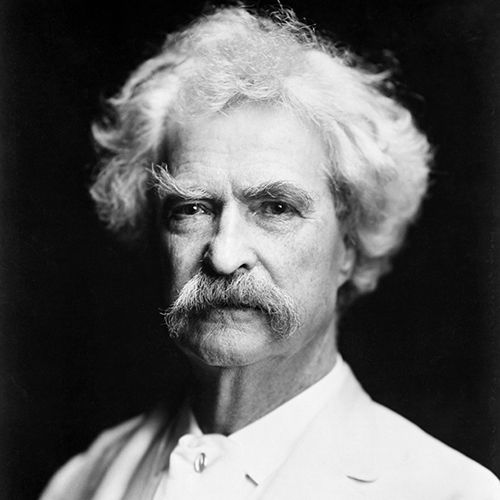
(1835-1910)

Who Was Mark Twain?
Mark Twain, whose real name was Samuel Clemens, was the celebrated author of several novels, including two major classics of American literature: The Adventures of Tom Sawyer and Adventures of Huckleberry Finn . He was also a riverboat pilot, journalist, lecturer, entrepreneur and inventor.
Twain was born Samuel Langhorne Clemens in the tiny village of Florida, Missouri, on November 30, 1835, the sixth child of John and Jane Clemens. When he was 4 years old, his family moved to nearby Hannibal, a bustling river town of 1,000 people.
John Clemens worked as a storekeeper, lawyer, judge and land speculator, dreaming of wealth but never achieving it, sometimes finding it hard to feed his family. He was an unsmiling fellow; according to one legend, young Sam never saw his father laugh.
His mother, by contrast, was a fun-loving, tenderhearted homemaker who whiled away many a winter's night for her family by telling stories. She became head of the household in 1847 when John died unexpectedly.
The Clemens family "now became almost destitute," wrote biographer Everett Emerson, and was forced into years of economic struggle — a fact that would shape the career of Twain.
Twain in Hannibal
Twain stayed in Hannibal until age 17. The town, situated on the Mississippi River, was in many ways a splendid place to grow up.
Steamboats arrived there three times a day, tooting their whistles; circuses, minstrel shows and revivalists paid visits; a decent library was available; and tradesmen such as blacksmiths and tanners practiced their entertaining crafts for all to see.
However, violence was commonplace, and young Twain witnessed much death: When he was nine years old, he saw a local man murder a cattle rancher, and at 10 he watched an enslaved person die after a white overseer struck him with a piece of iron.
Hannibal inspired several of Twain's fictional locales, including "St. Petersburg" in Tom Sawyer and Huckleberry Finn. These imaginary river towns are complex places: sunlit and exuberant on the one hand, but also vipers' nests of cruelty, poverty, drunkenness, loneliness and soul-crushing boredom — all parts of Twain's boyhood experience.
Sam kept up his schooling until he was about 12 years old, when — with his father dead and the family needing a source of income — he found employment as an apprentice printer at the Hannibal Courier , which paid him with a meager ration of food. In 1851, at 15, he got a job as a printer and occasional writer and editor at the Hannibal Western Union , a little newspaper owned by his brother, Orion.
Steamboat Pilot
Twain loved his career — it was exciting, well-paying and high-status, roughly akin to flying a jetliner today. However, his service was cut short in 1861 by the outbreak of the Civil War , which halted most civilian traffic on the river.
As the Civil War began, the people of Missouri angrily split between support for the Union and the Confederate States . Twain opted for the latter, joining the Confederate Army in June 1861 but serving for only a couple of weeks until his volunteer unit disbanded.
Where, he wondered then, would he find his future? What venue would bring him both excitement and cash? His answer: the great American West.
Heading Out West
In July 1861, Twain climbed on board a stagecoach and headed for Nevada and California, where he would live for the next five years.
At first, he prospected for silver and gold, convinced that he would become the savior of his struggling family and the sharpest-dressed man in Virginia City and San Francisco. But nothing panned out, and by the middle of 1862, he was flat broke and in need of a regular job.
Twain knew his way around a newspaper office, so that September, he went to work as a reporter for the Virginia City Territorial Enterprise . He churned out news stories, editorials and sketches, and along the way adopted the pen name Mark Twain — steamboat slang for 12 feet of water.
Twain became one of the best-known storytellers in the West. He honed a distinctive narrative style — friendly, funny, irreverent, often satirical and always eager to deflate the pretentious.
He got a big break in 1865, when one of his tales about life in a mining camp, "Jim Smiley and His Jumping Frog," was printed in newspapers and magazines around the country (the story later appeared under various titles).
'Innocents Abroad'
His next step up the ladder of success came in 1867, when he took a five-month sea cruise in the Mediterranean, writing humorously about the sights for American newspapers with an eye toward getting a book out of the trip.
In 1869, The Innocents Abroad was published, and it became a nationwide bestseller.
At 34, this handsome, red-haired, affable, canny, egocentric and ambitious journalist and traveler had become one of the most popular and famous writers in America.
Marriage to Olivia Langdon
However, Twain worried about being a Westerner. In those years, the country's cultural life was dictated by an Eastern establishment centered in New York City and Boston — a straight-laced, Victorian , moneyed group that cowed Twain.
"An indisputable and almost overwhelming sense of inferiority bounced around his psyche," wrote scholar Hamlin Hill, noting that these feelings were competing with his aggressiveness and vanity. Twain's fervent wish was to get rich, support his mother, rise socially and receive what he called "the respectful regard of a high Eastern civilization."
In February 1870, he improved his social status by marrying 24-year-old Olivia (Livy) Langdon, the daughter of a rich New York coal merchant. Writing to a friend shortly after his wedding, Twain could not believe his good luck: "I have ... the only sweetheart I have ever loved ... she is the best girl, and the sweetest, and gentlest, and the daintiest, and she is the most perfect gem of womankind."
Livy, like many people during that time, took pride in her pious, high-minded, genteel approach to life. Twain hoped that she would "reform" him, a mere humorist, from his rustic ways. The couple settled in Buffalo and later had four children.
DOWNLOAD BIOGRAPHY'S MARK TWAIN FACT CARD

Mark Twain's Books
Thankfully, Twain's glorious "low-minded" Western voice broke through on occasion.
'The Adventures of Tom Sawyer'
The Adventures of Tom Sawyer was published in 1876, and soon thereafter he began writing a sequel, Adventures of Huckleberry Finn.
Writing this work, commented biographer Everett Emerson, freed Twain temporarily from the "inhibitions of the culture he had chosen to embrace."
'Adventures of Huckleberry Finn'
"All modern American literature comes from one book by Twain called Huckleberry Finn ," Ernest Hemingway wrote in 1935, giving short shrift to Herman Melville and others but making an interesting point.
Hemingway's comment refers specifically to the colloquial language of Twain's masterpiece, as for perhaps the first time in America, the vivid, raw, not-so-respectable voice of the common folk was used to create great literature.
Huck Finn required years to conceptualize and write, and Twain often put it aside. In the meantime, he pursued respectability with the 1881 publication of The Prince and the Pauper , a charming novel endorsed with enthusiasm by his genteel family and friends.
'Life on the Mississippi'
In 1883 he put out Life on the Mississippi , an interesting but safe travel book. When Huck Finn finally was published in 1884, Livy gave it a chilly reception.
After that, business and writing were of equal value to Twain as he set about his cardinal task of earning a lot of money. In 1885, he triumphed as a book publisher by issuing the bestselling memoirs of former President Ulysses S. Grant , who had just died.
He lavished many hours on this and other business ventures, and was certain that his efforts would be rewarded with enormous wealth, but he never achieved the success he expected. His publishing house eventually went bankrupt.
'A Connecticut Yankee in King Arthur's Court'
Twain's financial failings, reminiscent in some ways of his father's, had serious consequences for his state of mind. They contributed powerfully to a growing pessimism in him, a deep-down feeling that human existence is a cosmic joke perpetrated by a chuckling God.
Another cause of his angst, perhaps, was his unconscious anger at himself for not giving undivided attention to his deepest creative instincts, which centered on his Missouri boyhood.
In 1889, Twain published A Connecticut Yankee in King Arthur's Court , a science-fiction/historical novel about ancient England. His next major work, in 1894, was The Tragedy of Pudd'nhead Wilson , a somber novel that some observers described as "bitter."
He also wrote short stories, essays and several other books, including a study of Joan of Arc . Some of these later works have enduring merit, and his unfinished work The Chronicle of Young Satan has fervent admirers today.
Twain's last 15 years were filled with public honors, including degrees from Oxford and Yale . Probably the most famous American of the late 19th century, he was much photographed and applauded wherever he went.
Indeed, he was one of the most prominent celebrities in the world, traveling widely overseas, including a successful 'round-the-world lecture tour in 1895-96, undertaken to pay off his debts.
Family Struggles
But while those years were gilded with awards, they also brought him much anguish. Early in their marriage, he and Livy had lost their toddler son, Langdon, to diphtheria; in 1896, his favorite daughter, Susy, died at the age of 24 of spinal meningitis. The loss broke his heart, and adding to his grief, he was out of the country when it happened.
His youngest daughter, Jean, was diagnosed with severe epilepsy. In 1909, when she was 29 years old, Jean died of a heart attack. For many years, Twain's relationship with middle daughter Clara was distant and full of quarrels.
In June 1904, while Twain traveled, Livy died after a long illness. "The full nature of his feelings toward her is puzzling," wrote scholar R. Kent Rasmussen. "If he treasured Livy's comradeship as much as he often said, why did he spend so much time away from her?"
But absent or not, throughout 34 years of marriage, Twain had indeed loved his wife. "Wheresoever she was, there was Eden," he wrote in tribute to her.
Twain became somewhat bitter in his later years, even while projecting an amiable persona to his public. In private he demonstrated a stunning insensitivity to friends and loved ones.
"Much of the last decade of his life, he lived in hell," wrote Hamlin Hill. He wrote a fair amount but was unable to finish most of his projects. His memory faltered.
Twain suffered volcanic rages and nasty bouts of paranoia, and he experienced many periods of depressed indolence, which he tried to assuage by smoking cigars, reading in bed and playing endless hours of billiards and cards.
Twain died on April 21, 1910, at the age of 74. He was buried in Elmira, New York.
The Mark Twain House in Hartford, Connecticut, is now a popular attraction and is designated a National Historic Landmark.
Twain is remembered as a great chronicler of American life in the 19th and early 20th centuries. Writing grand tales about Sawyer, Finn and the mighty Mississippi River, Twain explored the American soul with wit, buoyancy and a sharp eye for truth.
QUICK FACTS
- Name: Mark Twain
- Birth Year: 1835
- Birth date: November 30, 1835
- Birth State: Missouri
- Birth City: Florida
- Birth Country: United States
- Gender: Male
- Best Known For: Mark Twain, the writer, adventurer and wily social critic born Samuel Clemens, wrote the novels 'Adventures of Tom Sawyer' and 'Adventures of Huckleberry Finn.’
- Writing and Publishing
- Astrological Sign: Sagittarius
- Death Year: 1910
- Death date: April 21, 1910
- Death State: Connecticut
- Death City: Redding
- Death Country: United States
We strive for accuracy and fairness.If you see something that doesn't look right, contact us !
CITATION INFORMATION
- Article Title: Mark Twain Biography
- Author: Biography.com Editors
- Website Name: The Biography.com website
- Url: https://www.biography.com/authors-writers/mark-twain
- Access Date:
- Publisher: A&E; Television Networks
- Last Updated: March 31, 2021
- Original Published Date: April 3, 2014
- This is the day upon which we are reminded of what we are on the other 364.
- Civilization is a limitless multiplication of unnecessary necessaries.
- New Year's is a harmless annual institution, of no particular use to anybody save as a scapegoat for promiscuous drunks, and friendly calls, and humbug resolutions.
- The radical invents the views. When he has worn them out, the conservative adopts them.
- I'd rather have my ignorance than another man's knowledge, because I've got so much more of it.
- Everybody talks about the weather, but nobody does anything about it.
- Do not put off 'til tomorrow what can be put off 'til day-after-tomorrow just as well.
- In order to make a man or a boy covet a thing, it is only necessary to make the thing difficult to obtain.
- 'Classic'—a book which people praise and don't read.
- When angry, count four. When very angry, swear.
- Whenever you find yourself on the side of the majority, it is time to pause and reflect.
- We can't reach old age by another man's road. My habits protect my life, but would assassinate you.
- Be good and you will be lonesome.
Watch Next .css-16toot1:after{background-color:#262626;color:#fff;margin-left:1.8rem;margin-top:1.25rem;width:1.5rem;height:0.063rem;content:'';display:-webkit-box;display:-webkit-flex;display:-ms-flexbox;display:flex;}

Famous Authors & Writers

A Huge Shakespeare Mystery, Solved

Shakespeare Wrote 3 Tragedies in Turbulent Times
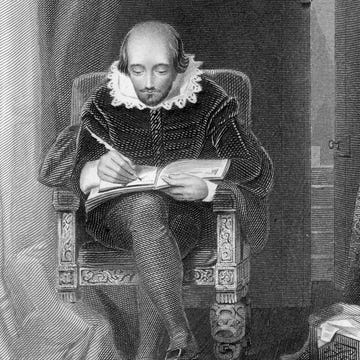
The Mystery of Shakespeare's Life and Death
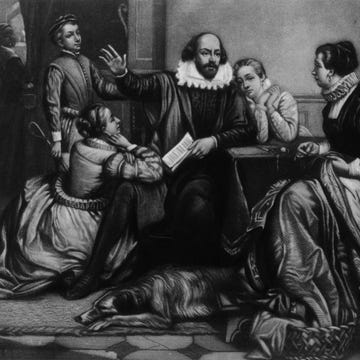
Was Shakespeare the Real Author of His Plays?
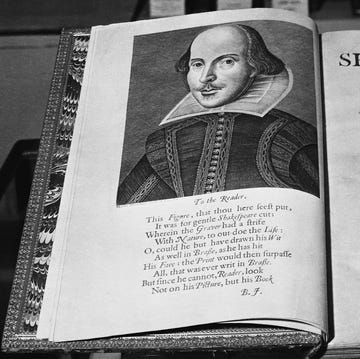
20 Shakespeare Quotes

William Shakespeare

The Ultimate William Shakespeare Study Guide

Suzanne Collins

Alice Munro

Agatha Christie

A Life Lived in a Rapidly Changing World: Samuel L. Clemens‚ 1835-1910
As twain’s books provide insight into the past‚ the events of his personal life further demonstrate his role as an eyewitness to history..
During his lifetime‚ Sam Clemens watched a young United States evolve from a nation torn apart by internal conflicts to one of international power. He experienced America’s vast growth and change – from westward expansion to industrialization‚ the end of slavery‚ advancements in technology‚ big government and foreign wars. And along the way‚ he often had something to say about the changes happening in his country.
The Early Years
Samuel Clemens was born on November 30‚ 1835 in Florida‚ Missouri‚ the sixth of seven children. At age 4‚ Sam and his family moved to the small frontier town of Hannibal‚ Missouri‚ on the banks of the Mississippi River. Missouri‚ at the time‚ was a fairly new state (it had gained statehood in 1821) and made up part of the country’s western border. It was also a state that took part in slavery. Sam’s father owned one enslaved person, and his uncle owned several. In fact‚ it was on his uncle’s farm that Sam spent many boyhood summers playing in the enslaved people’s quarters‚ listening to tall tales and the spirituals that he would enjoy throughout his life.
In 1847‚ when Sam was 11‚ his father died. Shortly thereafter he left school to work as a printer’s apprentice for a local newspaper. His job was to arrange the type for each of the newspaper’s stories‚ allowing Sam to read the news of the world while completing his work.
Twain’s Young Adult Life
At 18‚ Sam headed east to New York City and Philadelphia‚ where he worked on several different newspapers and found some success at writing articles. By 1857‚ he had returned home to embark on a new career as a riverboat pilot on the Mississippi River. With the outbreak of the Civil War in 1861‚ however‚ all traffic along the river came to a halt‚ as did Sam’s pilot career. Inspired by the times‚ Sam joined up with a volunteer Confederate unit called the Marion Rangers‚ but he quit after just two weeks.
In search of a new career‚ Sam headed west in July 1861‚ at the invitation of his brother‚ Orion‚ who had just been appointed secretary of the Nevada Territory. Lured by the infectious hope of striking it rich in Nevada’s silver rush‚ Sam traveled across the open frontier from Missouri to Nevada by stagecoach. Along the journey Sam encountered Native American tribes for the first time, along with a variety of unique characters‚ mishaps, and disappointments. These events would find a way into his short stories and books‚ particularly Roughing It .
After failing as a silver prospector‚ Sam began writing for the Territorial Enterprise‚ a Virginia City‚ Nevada newspaper where he used‚ for the first time‚ his pen name‚ Mark Twain. Seeking change, by 1864 Sam headed for San Francisco where he continued to write for local papers.
In 1865 Sam’s first “big break” came with the publication of his short story “Jim Smiley and His Jumping Frog ” in papers across the country. A year later Sam was hired by the Sacramento Union to visit and report on the Sandwich Islands (now Hawaii). His writings were so popular that‚ upon his return‚ he embarked upon his first lecture tour‚ which established him as a successful stage performer.
Hired by the Alta California to continue his travel writing from the east‚ Sam arrived in New York City in 1867. He quickly signed up for a steamship tour of Europe and the “Holy Land.” His travel letters‚ full of vivid descriptions and tongue-in-cheek observations‚ met with such audience approval that they were later reworked into his first book‚ The Innocents Abroad , published in 1869. It was also on this trip that Clemens met his future brother-in-law‚ Charles Langdon. Langdon reportedly showed Sam a picture of his sister‚ Olivia ‚ and Sam fell in love at first sight.
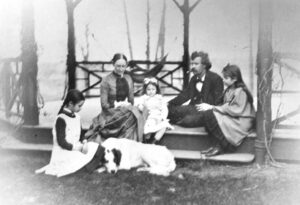
Twain Starts a Family and Moves to Hartford
After courting for two years‚ Sam Clemens and Olivia (Livy) Langdon were married in 1870. They settled in Buffalo‚ New York‚ where Sam had become a partner‚ editor, and writer for the daily newspaper the Buffalo Express . While they were living in Buffalo‚ their first child‚ Langdon Clemens‚ was born.
In 1871 Sam moved his family to Hartford‚ Connecticut‚ a city he had come to love while visiting his publisher there and where he had made friends. Livy also had family connections to the city. For the first few years the Clemenses rented a house in the heart of Nook Farm‚ a residential area that was home to numerous writers‚ publishers, and other prominent figures. In 1872 Sam’s recollections and tall tales from his frontier adventures were published in his book Roughing It . That same year the Clemenses’ first daughter Susy was born‚ but their son‚ Langdon‚ died at age two from diphtheria.
In 1873 Sam’s focus turned toward social criticism. He and Hartford Courant publisher Charles Dudley Warner co-wrote The Gilded Age ‚ a novel that attacked political corruption‚ big business, and the American obsession with getting rich that seemed to dominate the era. Ironically‚ a year after its publication‚ the Clemenses’ elaborate 25-room house on Farmington Avenue‚ which had cost the then-huge sum of $40‚000-$45‚000‚ was completed.
Twain Writes his Most Famous Books While Living in Hartford
For the next 17 years (1874-1891)‚ Sam‚ Livy, and their three daughters (Clara was born in 1874 and Jean in 1880) lived in the Hartford home. During those years Sam completed some of his most famous books‚ often finding a summer refuge for uninterrupted work at his sister-in-law’s farm in Elmira‚ New York. Novels such as The Adventures of Tom Sawyer (1876) and Life on the Mississippi (1883) captured both his Missouri memories and depictions of the American scene. Yet his social commentary continued. The Prince and the Pauper (1881) explored class relations, as does A Connecticut Yankee in King Arthur’s Court (1889), which‚ going a step further‚ criticized oppression in general while examining the period’s explosion of new technologies. And‚ in perhaps his most famous work‚ Adventures of Huckleberry Finn (1884)‚ Clemens‚ by the way he attacked the institution of slavery‚ railed against the failures of Reconstruction and the continued poor treatment of African Americans in his own time.
Huckleberry Finn was also the first book published by Sam’s own publishing company‚ The Charles L. Webster Company. In an attempt to gain control over publication as well as to make substantial profits‚ Sam created the company in 1884. A year later he contracted with Ulysses S. Grant to publish Grant’s memoirs; the two-volume set provided large royalties for Grant’s widow and was a financial success for the publisher as well.
Twain’s Financial Ruin and Subsequent Travels
Although Sam enjoyed financial success during his Hartford years‚ he continually made bad investments in new inventions‚ which eventually brought him to bankruptcy. In an effort to economize and pay back his debts‚ Sam and Livy moved their family to Europe in 1891. When his publishing company failed in 1894‚ Sam was forced to set out on a worldwide lecture tour to earn money. In 1896 tragedy struck when Susy Clemens‚ at age 24‚ died from meningitis while on a visit to the Hartford home. Unable to bear being in the place of her death‚ the Clemenses never returned to Hartford to live.
From 1891 until 1900‚ Sam and his family traveled throughout the world. During those years Sam witnessed the increasing exploitation of weaker governments by European powers‚ which he described in his book Following the Equator (1897). The Boer War in South Africa and the Boxer Rebellion in China fueled his growing anger toward imperialistic countries and their actions. With the Spanish-American and Philippine wars in 1898‚ Sam’s wrath was redirected toward the American government. When he returned to the United States in 1900‚ his finances restored‚ Sam readily declared himself an anti-imperialist and‚ from 1901 until his death‚ served as the vice president of the Anti-Imperialist League.
Twain’s Darkest Times and Late Life
In these later years‚ Sam’s writings turned dark. They began to focus on human greed and cruelty and questioned the humanity of the human race. His public speeches followed suit and included a harshly sarcastic public introduction of Winston Churchill in 1900. Even though Sam’s lecture tour had managed to get him out of debt‚ his anti-government writings and speeches threatened his livelihood once again. As Sam was labeled by some as a traitor‚ several of his works were never published during his lifetime, either because magazines would not accept them or because of his own personal fear that his marketable reputation would be ruined.
In 1903‚ after living in New York City for three years‚ Livy became ill, and Sam and his wife returned to Italy, where she died a year later. After her death‚ Sam lived in New York until 1908, when he moved into his last house‚ “Stormfield,” in Redding‚ Connecticut. In 1909 his middle daughter Clara was married. In the same year Jean‚ the youngest daughter‚ died from an epileptic seizure. Four months later, on April 21‚ 1910‚ Sam Clemens died at age 74.
Like any good journalist‚ Sam Clemens‚ a.k.a. Mark Twain‚ spent his life observing and reporting on his surroundings. In his writings he provided images of the romantic‚ the real‚ the strengths and weaknesses of a rapidly changing world. By examining his life and his works‚ we can read into the past – piecing together various events of the era and the responses to them. We can delve into the American mindset of the late nineteenth century and make our own observations of history‚ discover new connections‚ create new inferences and gain better insights into the time period and the people who lived in it. As Sam once wrote‚ “Supposing is good‚ but finding out is better.”
Mark Twain: His Life and His Humor
- Authors & Texts
- Top Picks Lists
- Study Guides
- Best Sellers
- Plays & Drama
- Shakespeare
- Short Stories
- Children's Books
- MLA, Harvard Graduate School of Design
Mark Twain, born Samuel Langhorne Clemens Nov. 30, 1835 in the small town of Florida, MO, and raised in Hannibal, became one of the greatest American authors of all time. Known for his sharp wit and pithy commentary on society, politics, and the human condition, his many essays and novels, including the American classic, The Adventures of Huckleberry Finn , are a testament to his intelligence and insight. Using humor and satire to soften the edges of his keen observations and critiques, he revealed in his writing some of the injustices and absurdities of society and human existence, his own included. He was a humorist, writer, publisher, entrepreneur, lecturer, iconic celebrity (who always wore white at his lectures), political satirist, and social progressive .
He died on April 21, 1910 when Halley’s Comet was again visible in the night sky, as lore would have it, just as it had been when he was born 75 years earlier. Wryly and presciently, Twain had said, “I came in with Halley's Comet in 1835. It is coming again next year (1910), and I expect to go out with it. It will be the greatest disappointment of my life if I don't go out with Halley's Comet. The Almighty has said, no doubt: "Now here are these two unaccountable freaks; they came in together, they must go out together.” Twain died of a heart attack one day after the Comet appeared its brightest in 1910.
A complex, idiosyncratic person, he never liked to be introduced by someone else when lecturing, preferring instead to introduce himself as he did when beginning the following lecture, “Our Fellow Savages of the Sandwich Islands” in 1866:
“Ladies and gentlemen: The next lecture in this course will be delivered this evening, by Samuel L. Clemens, a gentleman whose high character and unimpeachable integrity are only equalled by his comeliness of person and grace of manner. And I am the man! I was obliged to excuse the chairman from introducing me, because he never compliments anybody and I knew I could do it just as well.”
Twain was a complicated mixture of southern boy and western ruffian striving to fit into elite Yankee culture. He wrote in his speech, Plymouth Rock and the Pilgrims,1881 :
“I am a border-ruffian from the State of Missouri. I am a Connecticut Yankee by adoption. In me, you have Missouri morals, Connecticut culture; this, gentlemen, is the combination which makes the perfect man.”
Growing up in Hannibal, Missouri had a lasting influence on Twain, and working as a steamboat captain for several years before the Civil War was one of his greatest pleasures. While riding the steamboat he would observe the many passengers, learning much about their character and affect. His time working as a miner and a journalist in Nevada and California during the 1860s introduced him to the rough and tumble ways of the west, which is where, Feb. 3, 1863, he first used the pen name, Mark Twain, when writing one of his humorous essays for the Virginia City Territorial Enterprise in Nevada.
Mark Twain was a riverboat term that means two fathoms, the point at which it is safe for the boat to navigate the waters. It seems that when Samuel Clemens adopted this pen name he also adopted another persona - a persona that represented the outspoken commoner, poking fun at the aristocrats in power, while Samuel Clemens, himself, strove to be one of them.
Twain got his first big break as a writer in 1865 with an article about life in a mining camp, called Jim Smiley and His Jumping Frog , also called The Celebrated Jumping Frog of Calaveras County . It was very favorably received and printed in newspapers and magazines all over the country. From there he received other jobs, sent to Hawaii, and then to Europe and the Holy Land as a travel writer. Out of these travels he wrote the book, The Innocents Abroad , in 1869, which became a bestseller. His books and essays were generally so well-regarded that he started lecturing and promoting them, becoming popular both as a writer and a speaker.
When he married Olivia Langdon in 1870, he married into a wealthy family from Elmira, New York and moved east to Buffalo, NY and then to Hartford, CT where he collaborated with the Hartford Courant Publisher to co-write The Gilded Age, a satirical novel about greed and corruption among the wealthy after the Civil War. Ironically, this was also the society to which he aspired and gained entry. But Twain had his share of losses, too - loss of fortune investing in failed inventions (and failing to invest in successful ones such as Alexander Graham Bell’s telephone ), and the deaths of people he loved, such as his younger brother in a riverboat accident, for which he felt responsible, and several of his children and his beloved wife.
Although Twain survived, thrived, and made a living out of humor, his humor was borne out of sorrow, a complicated view of life, an understanding of life’s contradictions, cruelties, and absurdities. As he once said, “ There is no laughter in heaven .”
Mark Twain’s style of humor was wry, pointed, memorable, and delivered in a slow drawl. Twain’s humor carried on the tradition of humor of the Southwest, consisting of tall tales, myths, and frontier sketches, informed by his experiences growing up in Hannibal, MO, as a steamboat pilot on the Mississippi River, and as a gold miner and journalist in Nevada and California.
In 1863 Mark Twain attended in Nevada the lecture of Artemus Ward (pseudonym of Charles Farrar Browne,1834-1867), one of America’s best-known humorists of the 19th century. They became friends, and Twain learned much from him about how to make people laugh. Twain believed that how a story was told was what made it funny - repetition, pauses, and an air of naivety.
In his essay How to Tell a Story Twain says, “There are several kinds of stories, but only one difficult kind—the humorous. I will talk mainly about that one.” He describes what makes a story funny, and what distinguishes the American story from that of the English or French; namely that the American story is humorous, the English is comic, and the French is witty.
He explains how they differ:
“The humorous story depends for its effect upon the manner of the telling; the comic story and the witty story upon the matter. The humorous story may be spun out to great length, and may wander around as much as it pleases, and arrive nowhere in particular; but the comic and witty stories must be brief and end with a point. The humorous story bubbles gently along, the others burst. The humorous story is strictly a work of art, — high and delicate art, — and only an artist can tell it; but no art is necessary in telling the comic and the witty story; anybody can do it. The art of telling a humorous story —- understand, I mean by word of mouth, not print — was created in America, and has remained at home.”
Other important characteristics of a good humorous story, according to Twain, include the following:
- A humorous story is told gravely, as though there is nothing funny about it.
- The story is told wanderingly and the point is “slurred.”
- A “studied remark” is made as if without even knowing it, “as if one were thinking aloud.”
- The pause: “The pause is an exceedingly important feature in any kind of story, and a frequently recurring feature, too. It is a dainty thing, and delicate, and also uncertain and treacherous; for it must be exactly the right length--no more and no less—or it fails of its purpose and makes trouble. If the pause is too short the impressive point is passed, and the audience have had time to divine that a surprise is intended—and then you can't surprise them, of course.”
Twain believed in telling a story in an understated way, almost as if he was letting his audience in on a secret. He cites a story, The Wounded Soldier , as an example and to explain the difference in the different manners of storytelling, explaining that:
“The American would conceal the fact that he even dimly suspects that there is anything funny about it…. the American tells it in a ‘rambling and disjointed’ fashion and pretends that he does not know that it is funny at all,” whereas “The European ‘tells you beforehand that it is one of the funniest things he has ever heard, then tells it with eager delight, and is the first person to laugh when he gets through.” ….”All of which,” Mark Twain sadly comments, “is very depressing, and makes one want to renounce joking and lead a better life.”
Twain’s folksy, irreverent, understated style of humor, use of vernacular language, and seemingly forgetful rambling prose and strategic pauses drew his audience in, making them seem smarter than he. His intelligent satirical wit, impeccable timing, and ability to subtly poke fun at both himself and the elite made him accessible to a wide audience, and made him one of the most successful comedians of his time and one that has had a lasting influence on future comics and humorists.
Humor was absolutely essential to Mark Twain, helping him navigate life just as he learned to navigate the Mississippi when a young man, reading the depths and nuances of the human condition like he learned to see the subtleties and complexities of the river beneath its surface. He learned to create humor out of confusion and absurdity, bringing laughter into the lives of others as well. He once said, “Against the assault of laughter nothing can stand.”
MARK TWAIN PRIZE
Twain was much admired during his lifetime and recognized as an American icon. A prize created in his honor, The Mark Twain Prize for American Humor, the nation’s top comedy honor, has been given annually since 1998 to “people who have had an impact on American society in ways similar to the distinguished 19th century novelist and essayist best known as Mark Twain.” Previous recipients of the prize have included some of the most notable humorists of our time. The 2017 prizewinner is David Letterman, who according to Dave Itzkoff, New York Times writer , “Like Mark Twain …distinguished himself as a cockeyed, deadpan observer of American behavior and, later in life, for his prodigious and distinctive facial hair. Now the two satirists share a further connection.”
One can only wonder what remarks Mark Twain would make today about our government, ourselves, and the absurdities of our world. But undoubtedly they would be insightful and humorous to help us “stand against the assault” and perhaps even give us pause.
RESOURCES AND FURTHER READING
- Burns, Ken , Ken Burns Mark Twain Part I, https://www.youtube.com/watch?v=V-x_k7zrPUw
- Burns, Ken , Ken Burns Mark Twain Part II https://www.youtube.com/watch?v=1arrRQJkA28
- Mark Twain , http://www.cmgww.com/historic/twain/index.php/about/biography/
- Mark Twain , history.com , http://www.history.com/topics/mark-twain
- Railton, Stephen and University of Virginia Library, Mark Twain In His Times , http://twain.lib.virginia.edu/about/mtabout.html
- Mark Twain’s Interactive Scrapbook, PBS, http://www.pbs.org/marktwain/index.html
- Mark Twain’s America , IMAX,, https://www.youtube.com/watch?v=b0WioOn8Tkw (Video)
- Middlekauff, Robert, Mark Twain’s Humor - With Examples , https://amphilsoc.org/sites/default/files/proceedings/150305.pdf
- Moss, Walter, Mark Twain’s Progressive and Prophetic Political Humor, http://hollywoodprogressive.com/mark-twain/
- The Mark Twain House and Museum , https://www.marktwainhouse.org/man/biography_main.php
For Teachers :
- Learn More About Mark Twain , PBS, http://www.pbs.org/marktwain/learnmore/index.html
- Lesson 1: Mark Twain and American Humor, National Endowment for the Humanities, https://edsitement.neh.gov/lesson-plan/mark-twain-and-american-humor#sect-introduction
- Lesson Plan | Mark Twain and the Mark Twain Prize for American Humor , WGBH, PBS, https://mass.pbslearningmedia.org/resource/773460a8-d817-4fbd-9c1e-15656712348e/lesson-plan-mark-twain-and-the-mark-twain-prize-for-american-humor/#.WT2Y_DMfn-Y
- What Were Mark Twain's Inventions?
- The Story of Samuel Clemens as "Mark Twain"
- Who's the Real Huckleberry Finn?
- The Meaning of the Pseudonym Mark Twain
- Enslavement in Mark Twain's 'The Adventures of Huckleberry Finn'
- 'The Adventures of Huckleberry Finn' Quotes
- Mark Twain's Views on Enslavement
- Mark Twain's "A Letter From Santa Claus"
- 'The Adventures of Tom Sawyer' Summary and Takeaways
- A Reading List of the Best 19th Century Novels
- Biography of Samuel Johnson, 18th Century Writer and Lexicographer
- Biography of Willa Cather, American Author
- Biography of Washington Irving, Father of the American Short Story
- The Life and Work of H.G. Wells
- Biography of Nathaniel Hawthorne
- List of Works by James Fenimore Cooper
Biography Online

Mark Twain Biography
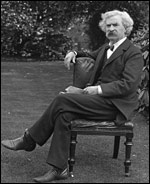
Early life of Mark Twain
Samuel Clemens (later better known by his pen name Mark Twain) was born in Florida, Missouri in 1835 to the son of a Tennessee country merchant. Twain was brought up in Hannibal, Missouri, a town on the great Mississippi River. At the age of 11, his father died and the next year Twain had to gain employment as a printer’s apprentice. From an early age, he began contributing articles and humorous sketches to the Hannibal Journal. At the age of 18, he left Missouri and went to New York, Philadelphia and St Louis. He furthered his education in public libraries and became active in the print unions. He was a vocal supporter of organised labour throughout his life, seeing how businesses were in a position to offer poor conditions and low pay to workers.
In 1859, he became a river pilot on the Mississippi River. It was a lucrative job with a salary of $250 a month. The job required great knowledge of the river which he assiduously gained.
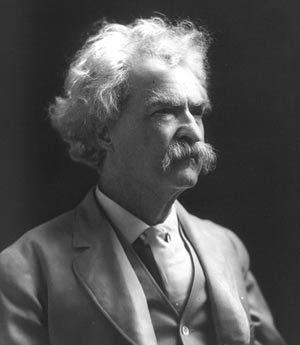
By 1865, he had his first major publishing success – “ The Celebrated Jumping Frog of Calaveras County “. This was a humorous tall tale which brought him much success. The popular acclaim for this first publishing success led to further travelling opportunities including a tour of Europe and the Middle East. This journey gave him material for his humorous travel diary – ‘ The Innocents Abroad’ ( 1869). Humour was an important element in Twain’s writings and speeches.
“Humor is the great thing, the saving thing. The minute it crops up, all our hardnesses yield, all our irritations and resentments flit away and a sunny spirit takes their place.” (1899)
Twain’s quick wit helped to make him one of the most famous Americans of his generation.
“Always acknowledge a fault. This will throw those in authority off their guard and give you an opportunity to commit more.”
― Mark Twain
In 1870, Mark Twain married Olivia Langdon. Olivia came from a wealthy and liberal NY family, who cultivated a wide circle of liberal and progressive activists. Through his wife, he met people such as Harriet Beecher Stowe and utopian socialist William Dean Howells. It was a very different society to the conservative slave state of Missouri where he had been brought up. He also became friendly with Helen Keller ; Twain was instrumental in helping to finance Keller’s education and was deeply impressed by her courage in overcoming her deafblindness.
Twain noted that he became more radical as his life progressed. He said that after an initial spell of enthusiasm for imperialism he became very suspicious of imperialist motives, e.g., he was critical of American intervention in the Philippines. Twain became vice-president of the American Anti-Imperialist League in 1901 until his death in 1910.
Twain was also a staunch supporter of abolition and black emancipation. He said that Lincoln’s Proclamation ‘Not only set the black slaves free but set the white man free also.’
The early works of Twain were generally light-hearted and humorous. However, as his writing and life developed, his books and articles increasingly became more serious and focused on the pressing social issues facing America.
“I have no color prejudices nor caste prejudices nor creed prejudices. All I care to know is that a man is a human being, and that is enough for me; he can’t be any worse.”
Harper’s Magazine , Sept. 1899
With the same deft touch and comic turn, Twain became a satirist on the cruelties and injustice of mankind and gave vent to his deeply held beliefs.
It is Tom Sawyer and Huckleberry Finn which are considered Twain’s greatest achievements. Hemingway later wrote that:
“All modern American literature comes from one book by Mark Twain called, Adventures of Huckleberry Finn.”
After working briefly for the Buffalo Express newspaper, Twain took his family and three daughters to live in Hartford, Connecticut. The family lived there for 17 years, and this gave Mark Twain a firm base to devote himself to writing. It was here that he wrote his best-known books – The Adventures of Tom Sawyer (1876), and Adventures of Huckleberry Finn (1864 ) As his fame and profile grew, Twain gained a substantial income through his writing. However, unfortunately, he lost a small fortune through a misplaced investment in the Paige typesetting machines. He is estimated to have lost $300,000 before it was made obsolete by the newly developed Linotype.
Combined with money lost through his own publishing house, Twain faced bankruptcy but was saved with the help of financier Henry Rogers. Twain then worked hard – undertaking a worldwide lecture tour to pay off his debts in full.
Despite a successful writing career and worldwide fame – which included an honorary doctorate from the University of Oxford – Twain suffered depression from painful personal tragedies. At an early age, Twain lost his first son. But, it was the death of his daughter, Sudsy, in 1896, which brought about an onset of real depression. This was further complicated by the death of his wife, Olivia in 1901.
Twain and Religion
“If Christ were here now there is one thing he would not be – a Christian”
– Mark Twain
Twain wrote many articles on religion – many of which weren’t published during his lifetime because they were considered too critical of religion. Twain criticised many aspects of organised religion and Christianity. He indicated that he believed in a God, but not in messages and revelations, which people often claimed came from God. His exact views are not precise as he expressed different opinions at different times. He was brought up a Presbyterian and later helped build a Presbyterian church for his brother.
Even as he approached the end of his life, Twain remained as witty as ever. A much-repeated quote in full is:
“James Ross Clemens, a cousin of mine, was seriously ill two or three weeks ago in London, but is well now. The report of my illness grew out of his illness; the report of my death was an exaggeration.”
Twain also satirised aspects of the Gilded Age of America – the unbridled pursuit of material wealth through corrupt and monopoly practices. In 1973, he wrote (with Charles Dudley Warner) The Gilded Age: A Tale of Today (1873). The book was Twain’s only collaboration, and although not too well known, the title came to describe the whole era of corruption and greed that epitomised aspects of America in the late Nineteenth Century.
Twain died on April 21st, 1910 from a heart attack – one day after Hailey’s Comet closest approach to earth. (Twain had been born close to Hailey Comet’s previous approach to earth in 1835.) In fact, in 1909, Twain had predicted he would die in close to proximity to the return of Hailey’s Comet.
As well as being a writer, Mark Twain had a fascination with science. He developed three inventions which gained patents; this included a self-pasting scrapbook.
Citation: Pettinger, Tejvan . “ Biography of Mark Twain ”, Oxford, UK www.biographyonline.net Published 21st February 2010. Updated 8th February 2018.
Mark Twain: Collection of short stories

Mark Twain: Collection of short stories at Amazon
Mark Twain: The Adventures of Tom Sawyer

Mark Twain: The Adventures of Tom Sawyer at Amazon
Related pages
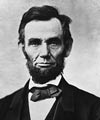
- Mark Twain Quotes
- History Classics
- Your Profile
- Find History on Facebook (Opens in a new window)
- Find History on Twitter (Opens in a new window)
- Find History on YouTube (Opens in a new window)
- Find History on Instagram (Opens in a new window)
- Find History on TikTok (Opens in a new window)
- This Day In History
- History Podcasts
- History Vault
By: History.com Editors
Updated: August 21, 2018 | Original: April 5, 2010

The name Mark Twain is a pseudonym of Samuel Langhorne Clemens. Clemens was an American humorist, journalist, lecturer, and novelist who acquired international fame for his travel narratives, especially The Innocents Abroad (1869), Roughing It (1872), and Life on the Mississippi (1883), and for his adventure stories of boyhood, especially The Adventures of Tom Sawyer (1876) and Adventures of Huckleberry Finn (1885). A gifted raconteur, distinctive humorist, and irascible moralist, he transcended the apparent limitations of his origins to become a popular public figure and one of America’s best and most beloved writers.
Samuel Clemens, the sixth child of John Marshall and Jane Moffit Clemens, was born two months prematurely and was in relatively poor health for the first 10 years of his life. His mother tried various allopathic and hydropathic remedies on him during those early years, and his recollections of those instances (along with other memories of his growing up) would eventually find their way into Tom Sawyer and other writings. Because he was sickly, Clemens was often coddled, particularly by his mother, and he developed early the tendency to test her indulgence through mischief, offering only his good nature as bond for the domestic crimes he was apt to commit. When Jane Clemens was in her 80s, Clemens asked her about his poor health in those early years: “I suppose that during that whole time you were uneasy about me?” “Yes, the whole time,” she answered. “Afraid I wouldn’t live?” “No,” she said, “afraid you would.”
Insofar as Clemens could be said to have inherited his sense of humour, it would have come from his mother, not his father. John Clemens, by all reports, was a serious man who seldom demonstrated affection. No doubt his temperament was affected by his worries over his financial situation, made all the more distressing by a series of business failures. It was the diminishing fortunes of the Clemens family that led them in 1839 to move 30 miles (50 km) east from Florida , Mo., to the Mississippi River port town of Hannibal , where there were greater opportunities. John Clemens opened a store and eventually became a justice of the peace, which entitled him to be called “Judge” but not to a great deal more. In the meantime, the debts accumulated. Still, John Clemens believed the Tennessee land he had purchased in the late 1820s (some 70,000 acres [28,000 hectares]) might one day make them wealthy, and this prospect cultivated in the children a dreamy hope. Late in his life, Twain reflected on this promise that became a curse:
It put our energies to sleep and made visionaries of us—dreamers and indolent.…It is good to begin life poor; it is good to begin life rich—these are wholesome; but to begin it prospectively rich! The man who has not experienced it cannot imagine the curse of it.
Judging from his own speculative ventures in silver mining, business, and publishing, it was a curse that Sam Clemens never quite outgrew.
Perhaps it was the romantic visionary in him that caused Clemens to recall his youth in Hannibal with such fondness. As he remembered it in Old Times on the Mississippi (1875), the village was a “white town drowsing in the sunshine of a summer’s morning,” until the arrival of a riverboat suddenly made it a hive of activity. The gamblers, stevedores, and pilots, the boisterous raftsmen and elegant travelers, all bound for somewhere surely glamorous and exciting, would have impressed a young boy and stimulated his already active imagination. And the lives he might imagine for these living people could easily be embroidered by the romantic exploits he read in the works of James Fenimore Cooper, Sir Walter Scott, and others. Those same adventures could be reenacted with his companions as well, and Clemens and his friends did play at being pirates, Robin Hood, and other fabled adventurers. Among those companions was Tom Blankenship, an affable but impoverished boy whom Twain later identified as the model for the character Huckleberry Finn. There were local diversions as well—fishing, picnicking, and swimming. A boy might swim or canoe to and explore Glasscock’s Island, in the middle of the Mississippi River, or he might visit the labyrinthine McDowell’s Cave, about 2 miles (3 km) south of town. The first site evidently became Jackson’s Island in Adventures of Huckleberry Finn; the second became McDougal’s Cave in The Adventures of Tom Sawyer. In the summers, Clemens visited his uncle John Quarles’s farm, near Florida, Mo., where he played with his cousins and listened to stories told by the slave Uncle Daniel, who served, in part, as a model for Jim in Huckleberry Finn.
It is not surprising that the pleasant events of youth, filtered through the softening lens of memory, might outweigh disturbing realities. However, in many ways the childhood of Samuel Clemens was a rough one. Death from disease during this time was common. His sister Margaret died of a fever when Clemens was not yet four years old; three years later his brother Benjamin died. When he was eight, a measles epidemic (potentially lethal in those days) was so frightening to him that he deliberately exposed himself to infection by climbing into bed with his friend Will Bowen in order to relieve the anxiety. A cholera epidemic a few years later killed at least 24 people, a substantial number for a small town. In 1847 Clemens’s father died of pneumonia. John Clemens’s death contributed further to the family’s financial instability. Even before that year, however, continuing debts had forced them to auction off property, to sell their only slave, Jennie, to take in boarders, even to sell their furniture.
Apart from family worries, the social environment was hardly idyllic. Missouri was a slave state, and, though the young Clemens had been reassured that chattel slavery was an institution approved by God, he nevertheless carried with him memories of cruelty and sadness that he would reflect upon in his maturity. Then there was the violence of Hannibal itself. One evening in 1844 Clemens discovered a corpse in his father’s office; it was the body of a California emigrant who had been stabbed in a quarrel and was placed there for the inquest. In January 1845 Clemens watched a man die in the street after he had been shot by a local merchant; this incident provided the basis for the Boggs shooting in Huckleberry Finn. Two years later he witnessed the drowning of one of his friends, and only a few days later, when he and some friends were fishing on Sny Island, on the Illinois side of the Mississippi, they discovered the drowned and mutilated body of a fugitive slave. As it turned out, Tom Blankenship’s older brother Bence had been secretly taking food to the runaway slave for some weeks before the slave was apparently discovered and killed. Bence’s act of courage and kindness served in some measure as a model for Huck’s decision to help the fugitive Jim in Huckleberry Finn.
After the death of his father, Sam Clemens worked at several odd jobs in town, and in 1848 he became a printer’s apprentice for Joseph P. Ament’s Missouri Courier. He lived sparingly in the Ament household but was allowed to continue his schooling and, from time to time, indulge in boyish amusements. Nevertheless, by the time Clemens was 13, his boyhood had effectively come to an end.
Apprenticeships
In 1850 the oldest Clemens boy, Orion, returned from St. Louis, Mo., and began to publish a weekly newspaper. A year later he bought the Hannibal Journal, and Sam and his younger brother Henry worked for him. Sam became more than competent as a typesetter, but he also occasionally contributed sketches and articles to his brother’s paper. Some of those early sketches, such as The Dandy Frightening the Squatter (1852), appeared in Eastern newspapers and periodicals. In 1852, acting as the substitute editor while Orion was out of town, Clemens signed a sketch “W. Epaminondas Adrastus Perkins.” This was his first known use of a pseudonym, and there would be several more ( Thomas Jefferson Snodgrass, Quintius Curtius Snodgrass, Josh, and others) before he adopted, permanently, the pen name Mark Twain.
Having acquired a trade by age 17, Clemens left Hannibal in 1853 with some degree of self-sufficiency. For almost two decades he would be an itinerant labourer, trying many occupations. It was not until he was 37, he once remarked, that he woke up to discover he had become a “literary person.” In the meantime, he was intent on seeing the world and exploring his own possibilities. He worked briefly as a typesetter in St. Louis in 1853 before traveling to New York City to work at a large printing shop. From there he went to Philadelphia and on to Washington , D.C.; then he returned to New York, only to find work hard to come by because of fires that destroyed two publishing houses. During his time in the East, which lasted until early 1854, he read widely and took in the sights of these cities. He was acquiring, if not a worldly air, at least a broader perspective than that offered by his rural background. And Clemens continued to write, though without firm literary ambitions, occasionally publishing letters in his brother’s new newspaper. Orion had moved briefly to Muscatine, Iowa , with their mother, where he had established the Muscatine Journal before relocating to Keokuk, Iowa, and opening a printing shop there. Sam Clemens joined his brother in Keokuk in 1855 and was a partner in the business for a little over a year, but he then moved to Cincinnati, Ohio , to work as a typesetter. Still restless and ambitious, he booked passage in 1857 on a steamboat bound for New Orleans , La., planning to find his fortune in South America. Instead, he saw a more immediate opportunity and persuaded the accomplished riverboat captain Horace Bixby to take him on as an apprentice.
Having agreed to pay a $500 apprentice fee, Clemens studied the Mississippi River and the operation of a riverboat under the masterful instruction of Bixby, with an eye toward obtaining a pilot’s license. (Clemens paid Bixby $100 down and promised to pay the remainder of the substantial fee in installments, something he evidently never managed to do.) Bixby did indeed “learn”—a word Twain insisted on—him the river, but the young man was an apt pupil as well. Because Bixby was an exceptional pilot and had a license to navigate the Missouri River and the upper as well as the lower Mississippi, lucrative opportunities several times took him upstream. On those occasions, Clemens was transferred to other veteran pilots and thereby learned the profession more quickly and thoroughly than he might have otherwise. The profession of riverboat pilot was, as he confessed many years later in Old Times on the Mississippi, the most congenial one he had ever followed. Not only did a pilot receive good wages and enjoy universal respect, but he was absolutely free and self-sufficient: “a pilot, in those days, was the only unfettered and entirely independent human being that lived in the earth,” he wrote. Clemens enjoyed the rank and dignity that came with the position; he belonged, both informally and officially, to a group of men whose acceptance he cherished; and—by virtue of his membership in the Western Boatman’s Benevolent Association, obtained soon after he earned his pilot’s license in 1859—he participated in a true “meritocracy” of the sort he admired and would dramatize many years later in A Connecticut Yankee in King Arthur’s Court (1889).
Clemens’s years on the river were eventful in other ways. He met and fell in love with Laura Wright, eight years his junior. The courtship dissolved in a misunderstanding, but she remained the remembered sweetheart of his youth. He also arranged a job for his younger brother Henry on the riverboat Pennsylvania . The boilers exploded, however, and Henry was fatally injured. Clemens was not on board when the accident occurred, but he blamed himself for the tragedy. His experience as a cub and then as a full-fledged pilot gave him a sense of discipline and direction he might never have acquired elsewhere. Before this period his had been a directionless knockabout life; afterward he had a sense of determined possibility. He continued to write occasional pieces throughout these years and, in one satirical sketch, River Intelligence (1859), lampooned the self-important senior pilot Isaiah Sellers, whose observations of the Mississippi were published in a New Orleans newspaper. Clemens and the other “starchy boys,” as he once described his fellow riverboat pilots in a letter to his wife, had no particular use for this nonunion man, but Clemens did envy what he later recalled to be Sellers’s delicious pen name, Mark Twain.
The Civil War severely curtailed river traffic, and, fearing that he might be impressed as a Union gunboat pilot, Clemens brought his years on the river to a halt a mere two years after he had acquired his license. He returned to Hannibal, where he joined the prosecessionist Marion Rangers, a ragtag lot of about a dozen men. After only two uneventful weeks, during which the soldiers mostly retreated from Union troops rumoured to be in the vicinity, the group disbanded. A few of the men joined other Confederate units, and the rest, along with Clemens, scattered. Twain would recall this experience, a bit fuzzily and with some fictional embellishments, in The Private History of the Campaign That Failed (1885). In that memoir he extenuated his history as a deserter on the grounds that he was not made for soldiering. Like the fictional Huckleberry Finn, whose narrative he was to publish in 1885, Clemens then lit out for the territory. Huck Finn intends to escape to the Indian country, probably Oklahoma ; Clemens accompanied his brother Orion to the Nevada Territory.
Clemens’s own political sympathies during the war are obscure. It is known at any rate that Orion Clemens was deeply involved in Republican Party politics and in Abraham Lincoln’s campaign for the U.S. presidency, and it was as a reward for those efforts that he was appointed territorial secretary of Nevada. Upon their arrival in Carson City, the territorial capital, Sam Clemens’s association with Orion did not provide him the sort of livelihood he might have supposed, and, once again, he had to shift for himself—mining and investing in timber and silver and gold stocks, oftentimes “prospectively rich,” but that was all. Clemens submitted several letters to the Virginia City Territorial Enterprise, and these attracted the attention of the editor, Joseph Goodman, who offered him a salaried job as a reporter. He was again embarked on an apprenticeship, in the hearty company of a group of writers sometimes called the Sagebrush Bohemians, and again he succeeded.
The Nevada Territory was a rambunctious and violent place during the boom years of the Comstock Lode, from its discovery in 1859 to its peak production in the late 1870s. Nearby Virginia City was known for its gambling and dance halls, its breweries and whiskey mills, its murders, riots, and political corruption. Years later Twain recalled the town in a public lecture: “It was no place for a Presbyterian,” he said. Then, after a thoughtful pause, he added, “And I did not remain one very long.” Nevertheless, he seems to have retained something of his moral integrity. He was often indignant and prone to expose fraud and corruption when he found them. This was a dangerous indulgence, for violent retribution was not uncommon.
In February 1863 Clemens covered the legislative session in Carson City and wrote three letters for the Enterprise. He signed them “Mark Twain.” Apparently the mistranscription of a telegram misled Clemens to believe that the pilot Isaiah Sellers had died and that his cognomen was up for grabs. Clemens seized it. (See Researcher’s Note: Origins of the name Mark Twain.) It would be several years before this pen name would acquire the firmness of a full-fledged literary persona, however. In the meantime, he was discovering by degrees what it meant to be a “literary person.”
Already he was acquiring a reputation outside the territory. Some of his articles and sketches had appeared in New York papers, and he became the Nevada correspondent for the San Francisco Morning Call. In 1864, after challenging the editor of a rival newspaper to a duel and then fearing the legal consequences for this indiscretion, he left Virginia City for San Francisco and became a full-time reporter for the Call. Finding that work tiresome, he began contributing to the Golden Era and the new literary magazine the Californian, edited by Bret Harte. After he published an article expressing his fiery indignation at police corruption in San Francisco, and after a man with whom he associated was arrested in a brawl, Clemens decided it prudent to leave the city for a time. He went to the Tuolumne foothills to do some mining. It was there that he heard the story of a jumping frog. The story was widely known, but it was new to Clemens, and he took notes for a literary representation of the tale. When the humorist Artemus Ward invited him to contribute something for a book of humorous sketches, Clemens decided to write up the story. Jim Smiley and His Jumping Frog arrived too late to be included in the volume, but it was published in the New York Saturday Press in November 1865 and was subsequently reprinted throughout the country. “Mark Twain” had acquired sudden celebrity, and Sam Clemens was following in his wake.
Literary Maturity
The next few years were important for Clemens. After he had finished writing the jumping-frog story but before it was published, he declared in a letter to Orion that he had a “ ‘call’ to literature of a low order—i.e. humorous. It is nothing to be proud of,” he continued, “but it is my strongest suit.” However much he might deprecate his calling, it appears that he was committed to making a professional career for himself. He continued to write for newspapers, traveling to Hawaii for the Sacramento Union and also writing for New York newspapers, but he apparently wanted to become something more than a journalist. He went on his first lecture tour, speaking mostly on the Sandwich Islands (Hawaii) in 1866. It was a success, and for the rest of his life, though he found touring grueling, he knew he could take to the lecture platform when he needed money. Meanwhile, he tried, unsuccessfully, to publish a book made up of his letters from Hawaii. His first book was in fact The Celebrated Jumping Frog of Calaveras County and Other Sketches (1867), but it did not sell well. That same year, he moved to New York City, serving as the traveling correspondent for the San Francisco Alta California and for New York newspapers. He had ambitions to enlarge his reputation and his audience, and the announcement of a transatlantic excursion to Europe and the Holy Land provided him with just such an opportunity. The Alta paid the substantial fare in exchange for some 50 letters he would write concerning the trip. Eventually his account of the voyage was published as The Innocents Abroad (1869). It was a great success.
The trip abroad was fortuitous in another way. He met on the boat a young man named Charlie Langdon, who invited Clemens to dine with his family in New York and introduced him to his sister Olivia; the writer fell in love with her. Clemens’s courtship of Olivia Langdon, the daughter of a prosperous businessman from Elmira, N.Y., was an ardent one, conducted mostly through correspondence. They were married in February 1870. With financial assistance from Olivia’s father, Clemens bought a one-third interest in the Express of Buffalo, N.Y., and began writing a column for a New York City magazine, the Galaxy. A son, Langdon, was born in November 1870, but the boy was frail and would die of diphtheria less than two years later. Clemens came to dislike Buffalo and hoped that he and his family might move to the Nook Farm area of Hartford, Conn. In the meantime, he worked hard on a book about his experiences in the West. Roughing It was published in February 1872 and sold well. The next month, Olivia Susan (Susy) Clemens was born in Elmira. Later that year, Clemens traveled to England. Upon his return, he began work with his friend Charles Dudley Warner on a satirical novel about political and financial corruption in the United States. The Gilded Age (1873) was remarkably well received, and a play based on the most amusing character from the novel, Colonel Sellers, also became quite popular.
The Gilded Age was Twain’s first attempt at a novel, and the experience was apparently congenial enough for him to begin writing Tom Sawyer, along with his reminiscences about his days as a riverboat pilot. He also published A True Story, a moving dialect sketch told by a former slave, in the prestigious Atlantic Monthly in 1874. A second daughter, Clara, was born in June, and the Clemenses moved into their still-unfinished house in Nook Farm later the same year, counting among their neighbours Warner and the writer Harriet Beecher Stowe . Old Times on the Mississippi appeared in the Atlantic in installments in 1875. The obscure journalist from the wilds of California and Nevada had arrived: he had settled down in a comfortable house with his family; he was known worldwide; his books sold well, and he was a popular favourite on the lecture tour; and his fortunes had steadily improved over the years. In the process, the journalistic and satirical temperament of the writer had, at times, become retrospective. Old Times, which would later become a portion of Life on the Mississippi, described comically, but a bit ruefully too, a way of life that would never return. The highly episodic narrative of Tom Sawyer, which recounts the mischievous adventures of a boy growing up along the Mississippi River, was coloured by a nostalgia for childhood and simplicity that would permit Twain to characterize the novel as a “hymn” to childhood. The continuing popularity of Tom Sawyer (it sold well from its first publication, in 1876, and has never gone out of print) indicates that Twain could write a novel that appealed to young and old readers alike. The antics and high adventure of Tom Sawyer and his comrades—including pranks in church and at school, the comic courtship of Becky Thatcher, a murder mystery, and a thrilling escape from a cave—continue to delight children, while the book’s comedy, narrated by someone who vividly recalls what it was to be a child, amuses adults with similar memories.
In the summer of 1876, while staying with his in-laws Susan and Theodore Crane on Quarry Farm overlooking Elmira, Clemens began writing what he called in a letter to his friend William Dean Howells “Huck Finn’s Autobiography.” Huck had appeared as a character in Tom Sawyer, and Clemens decided that the untutored boy had his own story to tell. He soon discovered that it had to be told in Huck’s own vernacular voice. Huckleberry Finn was written in fits and starts over an extended period and would not be published until 1885. During that interval, Twain often turned his attention to other projects, only to return again and again to the novel’s manuscript.
Twain believed he had humiliated himself before Boston’s literary worthies when he delivered one of many speeches at a dinner commemorating the 70th birthday of poet and abolitionist John Greenleaf Whittier. Twain’s contribution to the occasion fell flat (perhaps because of a failure of delivery or the contents of the speech itself), and some believed he had insulted three literary icons in particular: Henry Wadsworth Longfellow, Ralph Waldo Emerson, and Oliver Wendell Holmes . The embarrassing experience may have in part prompted his removal to Europe for nearly two years. He published A Tramp Abroad (1880), about his travels with his friend Joseph Twichell in the Black Forest and the Swiss Alps, and The Prince and the Pauper (1881), a fanciful tale set in 16th-century England and written for “young people of all ages.” In 1882 he traveled up the Mississippi with Horace Bixby, taking notes for the book that became Life on the Mississippi (1883). All the while, he continued to make often ill-advised investments, the most disastrous of which was the continued financial support of an inventor, James W. Paige, who was perfecting an automatic typesetting machine. In 1884 Clemens founded his own publishing company, bearing the name of his nephew and business agent, Charles L. Webster, and embarked on a four-month lecture tour with fellow author George W. Cable, both to raise money for the company and to promote the sales of Huckleberry Finn. Not long after that, Clemens began the first of several Tom-and-Huck sequels. None of them would rival Huckleberry Finn. All the Tom-and-Huck narratives engage in broad comedy and pointed satire, and they show that Twain had not lost his ability to speak in Huck’s voice. What distinguishes Huckleberry Finn from the others is the moral dilemma Huck faces in aiding the runaway slave Jim while at the same time escaping from the unwanted influences of so-called civilization. Through Huck, the novel’s narrator, Twain was able to address the shameful legacy of chattel slavery prior to the Civil War and the persistent racial discrimination and violence after. That he did so in the voice and consciousness of a 14-year-old boy, a character who shows the signs of having been trained to accept the cruel and indifferent attitudes of a slaveholding culture, gives the novel its affecting power, which can elicit genuine sympathies in readers but can also generate controversy and debate and can affront those who find the book patronizing toward African Americans, if not perhaps much worse. If Huckleberry Finn is a great book of American literature, its greatness may lie in its continuing ability to touch a nerve in the American national consciousness that is still raw and troubling.
For a time, Clemens’s prospects seemed rosy. After working closely with Ulysses S. Grant , he watched as his company’s publication of the former U.S. president’s memoirs in 1885–86 became an overwhelming success. Clemens believed a forthcoming biography of Pope Leo XIII would do even better. The prototype for the Paige typesetter also seemed to be working splendidly. It was in a generally sanguine mood that he began to write A Connecticut Yankee in King Arthur’s Court, about the exploits of a practical and democratic factory superintendent who is magically transported to Camelot and attempts to transform the kingdom according to 19th-century republican values and modern technology. So confident was he about prospects for the typesetter that Clemens predicted this novel would be his “swan-song” to literature and that he would live comfortably off the profits of his investment.
Things did not go according to plan, however. His publishing company was floundering, and cash flow problems meant he was drawing on his royalties to provide capital for the business. Clemens was suffering from rheumatism in his right arm, but he continued to write for magazines out of necessity. Still, he was getting deeper and deeper in debt, and by 1891 he had ceased his monthly payments to support work on the Paige typesetter, effectively giving up on an investment that over the years had cost him some $200,000 or more. He closed his beloved house in Hartford, and the family moved to Europe, where they might live more cheaply and, perhaps, where his wife, who had always been frail, might improve her health. Debts continued to mount, and the financial panic of 1893 made it difficult to borrow money. Luckily, he was befriended by a Standard Oil executive, Henry Huttleston Rogers, who undertook to put Clemens’s financial house in order. Clemens assigned his property, including his copyrights, to Olivia, announced the failure of his publishing house, and declared personal bankruptcy. In 1894, approaching his 60th year, Samuel Clemens was forced to repair his fortunes and to remake his career.
Late in 1894 The Tragedy of Pudd’nhead Wilson and the Comedy of Those Extraordinary Twins was published. Set in the antebellum South, Pudd’nhead Wilson concerns the fates of transposed babies, one white and the other black, and is a fascinating, if ambiguous, exploration of the social and legal construction of race. It also reflects Twain’s thoughts on determinism, a subject that would increasingly occupy his thoughts for the remainder of his life. One of the maxims from that novel jocularly expresses his point of view: “Training is everything. The peach was once a bitter almond; cauliflower is nothing but cabbage with a college education.” Clearly, despite his reversal of fortunes, Twain had not lost his sense of humour. But he was frustrated too—frustrated by financial difficulties but also by the public’s perception of him as a funnyman and nothing more. The persona of Mark Twain had become something of a curse for Samuel Clemens.
Clemens published his next novel, Personal Recollections of Joan of Arc (serialized 1895–96), anonymously in hopes that the public might take it more seriously than a book bearing the Mark Twain name. The strategy did not work, for it soon became generally known that he was the author; when the novel was first published in book form, in 1896, his name appeared on the volume’s spine but not on its title page. However, in later years he would publish some works anonymously, and still others he declared could not be published until long after his death, on the largely erroneous assumption that his true views would scandalize the public. Clemens’s sense of wounded pride was necessarily compromised by his indebtedness, and he embarked on a lecture tour in July 1895 that would take him across North America to Vancouver, B.C., Can., and from there around the world. He gave lectures in Australia, New Zealand, India, South Africa, and points in-between, arriving in England a little more than a year afterward. Clemens was in London when he was notified of the death of his daughter Susy, of spinal meningitis. A pall settled over the Clemens household; they would not celebrate birthdays or holidays for the next several years. As an antidote to his grief as much as anything else, Clemens threw himself into work. He wrote a great deal he did not intend to publish during those years, but he did publish Following the Equator (1897), a relatively serious account of his world lecture tour. By 1898 the revenue generated from the tour and the subsequent book, along with Henry Huttleston Rogers’s shrewd investments of his money, had allowed Clemens to pay his creditors in full. Rogers was shrewd as well in the way he publicized and redeemed the reputation of “Mark Twain” as a man of impeccable moral character. Palpable tokens of public approbation are the three honorary degrees conferred on Clemens in his last years—from Yale University in 1901, from the University of Missouri in 1902, and, the one he most coveted, from Oxford University in 1907. When he traveled to Missouri to receive his honorary Doctor of Laws, he visited old friends in Hannibal along the way. He knew that it would be his last visit to his hometown.
Clemens had acquired the esteem and moral authority he had yearned for only a few years before, and the writer made good use of his reinvigorated position. He began writing The Man That Corrupted Hadleyburg (1899), a devastating satire of venality in small-town America, and the first of three manuscript versions of The Mysterious Stranger. (None of the manuscripts was ever completed, and they were posthumously combined and published in 1916.) He also started What Is Man? (published anonymously in 1906), a dialogue in which a wise “Old Man” converts a resistant “Young Man” to a brand of philosophical determinism. He began to dictate his autobiography, which he would continue to do until a few months before he died. Some of Twain’s best work during his late years was not fiction but polemical essays in which his earnestness was not in doubt: an essay against anti-Semitism, Concerning the Jews (1899); a denunciation of imperialism, To the Man Sitting in Darkness (1901); an essay on lynching, The United States of Lyncherdom (posthumously published in 1923); and a pamphlet on the brutal and exploitative Belgian rule in the Congo, King Leopold’s Soliloquy (1905).
Clemens’s last years have been described as his “bad mood” period. The description may or may not be apt. It is true that in his polemical essays and in much of his fiction during this time he was venting powerful moral feelings and commenting freely on the “damn’d human race.” But he had always been against sham and corruption, greed, cruelty, and violence. Even in his California days, he was principally known as the “Moralist of the Main” and only incidentally as the “Wild Humorist of the Pacific Slope.” It was not the indignation he was expressing during these last years that was new; what seemed to be new was the frequent absence of the palliative humour that had seasoned the earlier outbursts. At any rate, even though the worst of his financial worries were behind him, there was no particular reason for Clemens to be in a good mood.
The family, including Clemens himself, had suffered from one sort of ailment or another for a very long time. In 1896 his daughter Jean was diagnosed with epilepsy, and the search for a cure, or at least relief, had taken the family to different doctors throughout Europe. By 1901 his wife’s health was seriously deteriorating. She was violently ill in 1902, and for a time Clemens was allowed to see her for only five minutes a day. Removing to Italy seemed to improve her condition, but that was only temporary. She died on June 5, 1904. Something of his affection for her and his sense of personal loss after her death is conveyed in the moving piece Eve’s Diary (1906). The story chronicles in tenderly comic ways the loving relationship between Adam and Eve. After Eve dies, Adam comments at her grave site, “Wheresoever she was, there was Eden.” Clemens had written a commemorative poem on the anniversary of Susy’s death, and Eve’s Diary serves the equivalent function for the death of his wife. He would have yet another occasion to publish his grief. His daughter Jean died on Dec. 24, 1909. The Death of Jean (1911) was written beside her deathbed. He was writing, he said, “to keep my heart from breaking.”
It is true that Clemens was bitter and lonely during his last years. He took some solace in the grandfatherly friendships he established with young schoolgirls he called his “angelfish.” His “Angelfish Club” consisted of 10 to 12 girls who were admitted to membership on the basis of their intelligence, sincerity, and good will, and he corresponded with them frequently. In 1906–07 he published selected chapters from his ongoing autobiography in the North American Review. Judging from the tone of the work, writing his autobiography often supplied Clemens with at least a wistful pleasure. These writings and others reveal an imaginative energy and humorous exuberance that do not fit the picture of a wholly bitter and cynical man. He moved into his new house in Redding, Conn., in June 1908, and that too was a comfort. He had wanted to call it “Innocents at Home,” but his daughter Clara convinced him to name it “Stormfield,” after a story he had written about a sea captain who sailed for heaven but arrived at the wrong port. Extracts from Captain Stormfield’s Visit to Heaven was published in installments in Harper’s Magazine in 1907–08. It is an uneven but delightfully humorous story, one that critic and journalist H.L. Mencken ranked on a level with Huckleberry Finn and Life on the Mississippi. Little Bessie and Letters from the Earth (both published posthumously) were also written during this period, and, while they are sardonic, they are antically comic as well. Clemens thought Letters from the Earth was so heretical that it could never be published. However, it was published in a book by that name, along with other previously unpublished writings, in 1962, and it reinvigorated public interest in Twain’s serious writings. The letters did present unorthodox views—that God was something of a bungling scientist and human beings his failed experiment, that Christ, not Satan, devised hell, and that God was ultimately to blame for human suffering, injustice, and hypocrisy. Twain was speaking candidly in his last years but still with a vitality and ironic detachment that kept his work from being merely the fulminations of an old and angry man.
Clara Clemens married in October 1909 and left for Europe by early December. Jean died later that month. Clemens was too grief-stricken to attend the burial services, and he stopped working on his autobiography. Perhaps as an escape from painful memories, he traveled to Bermuda in January 1910. By early April he was having severe chest pains. His biographer Albert Bigelow Paine joined him, and together they returned to Stormfield. Clemens died on April 21. The last piece of writing he did, evidently, was the short humorous sketch Etiquette for the Afterlife: Advice to Paine (first published in full in 1995). Clearly, Clemens’s mind was on final things; just as clearly, he had not altogether lost his sense of humour. Among the pieces of advice he offered Paine, for when his turn to enter heaven arrived, was this: “Leave your dog outside. Heaven goes by favor. If it went by merit, you would stay out and the dog would go in.” Clemens was buried in the family plot in Elmira, N.Y., alongside his wife, his son, and two of his daughters. Only Clara survived him.
Reputation and Assessment
Shortly after Clemens’s death, Howells published My Mark Twain (1910), in which he pronounced Samuel Clemens “sole, incomparable, the Lincoln of our literature.” Twenty-five years later Ernest Hemingway wrote in The Green Hills of Africa (1935), “All modern American literature comes from one book by Mark Twain called Huckleberry Finn.” Both compliments are grandiose and a bit obscure. For Howells, Twain’s significance was apparently social—the humorist, Howells wrote, spoke to and for the common American man and woman; he emancipated and dignified the speech and manners of a class of people largely neglected by writers (except as objects of fun or disapproval) and largely ignored by genteel America. For Hemingway, Twain’s achievement was evidently an aesthetic one principally located in one novel. For later generations, however, the reputation of and controversy surrounding Huckleberry Finn largely eclipsed the vast body of Clemens’s substantial literary corpus: the novel has been dropped from some American schools’ curricula on the basis of its characterization of the slave Jim, which some regard as demeaning, and its repeated use of an offensive racial epithet.
As a humorist and as a moralist, Twain worked best in short pieces. Roughing It is a rollicking account of his adventures in the American West, but it is also seasoned with such exquisite yarns as Buck Fanshaw’s Funeral and The Story of the Old Ram; A Tramp Abroad is for many readers a disappointment, but it does contain the nearly perfect Jim Baker’s Blue-Jay Yarn. In A True Story, told in an African American dialect, Twain transformed the resources of the typically American humorous story into something serious and profoundly moving. The Man That Corrupted Hadleyburg is relentless social satire; it is also the most formally controlled piece Twain ever wrote. The originality of the longer works is often to be found more in their conception than in their sustained execution. The Innocents Abroad is perhaps the funniest of all of Twain’s books, but it also redefined the genre of the travel narrative by attempting to suggest to the reader, as Twain wrote, “how he would be likely to see Europe and the East if he looked at them with his own eyes.” Similarly, in Tom Sawyer, he treated childhood not as the achievement of obedience to adult authority but as a period of mischief-making fun and good-natured affection. Like Miguel de Cervantes’s Don Quixote, which he much admired, Huckleberry Finn rang changes on the picaresque novel that are of permanent interest.
Twain was not the first Anglo-American to treat the problems of race and racism in all their complexity, but, along with that of Herman Melville, his treatment remains of vital interest more than a hundred years later. His ability to swiftly and convincingly create a variety of fictional characters rivals that of Charles Dickens. Twain’s scalawags, dreamers, stalwarts, and toughs, his solicitous aunts, ambitious politicians, carping widows, false aristocrats, canny but generous slaves, sententious moralists, brave but misguided children, and decent but complicitous bystanders, his loyal lovers and friends, and his fractious rivals—these and many more constitute a virtual census of American types. And his mastery of spoken language, of slang and argot and dialect, gave these figures a voice. Twain’s democratic sympathies and his steadfast refusal to condescend to the lowliest of his creations give the whole of his literary production a point of view that is far more expansive, interesting, and challenging than his somewhat crusty philosophical speculations. Howells, who had known most of the important American literary figures of the 19th century and thought them to be more or less like one another, believed that Twain was unique. Twain will always be remembered first and foremost as a humorist, but he was a great deal more—a public moralist, popular entertainer, political philosopher, travel writer, and novelist. Perhaps it is too much to claim, as some have, that Twain invented the American point of view in fiction, but that such a notion might be entertained indicates that his place in American literary culture is secure.
Thomas V. Quirk

Sign up for Inside History
Get HISTORY’s most fascinating stories delivered to your inbox three times a week.
By submitting your information, you agree to receive emails from HISTORY and A+E Networks. You can opt out at any time. You must be 16 years or older and a resident of the United States.
More details : Privacy Notice | Terms of Use | Contact Us
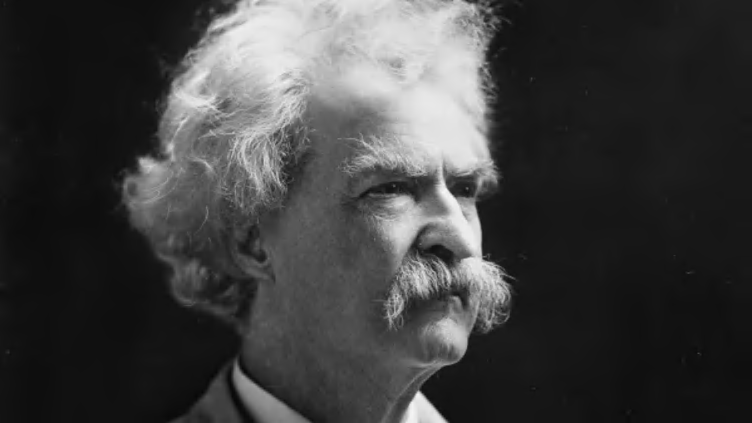
AUTHORS (1835–1910); FLORIDA, MISSOURI
Mark Twain, author of classic books such as The Adventures of Huckleberry Finn and The Gilded Age (plus a wide variety of short stories and other literature), had a quick wit and prolific body of work that has made him one of America's most quoted—and misquoted—writers. Find out more about his life and legacy, as well as some quotes about love, loss, and comedy.
1. Mark Twain’s real name was Samuel Langhorne Clemens.

After trying out other aliases like “Thomas Jefferson Snodgrass” and “Sergeant Fathom,” Samuel Langhorne Clemens adopted “ Mark Twain ” in 1863. He claimed the idea came from his stint as a Mississippi River steamboat captain before the Civil War—sailors used to call out “mark twain!” to identify when the water was two fathoms (or 12 feet) deep.
2. Samuel Clemens's signature was discovered in the Mark Twain Cave in July 2019.
Mark Twain was known to have spent his boyhood exploring the three miles of passageways in a cave in Hannibal, Missouri, that would later become the inspiration for a scene in The Adventures of Tom Sawyer . For more than a century, visitors have examined the walls for some sign of the author’s time there—and, during a tour in July 2019, one hawk-eyed spelunker finally spotted the word Clemens among the other names that line the walls.
3. The Mark Twain National Forest could’ve been named after a different famous Missourian.
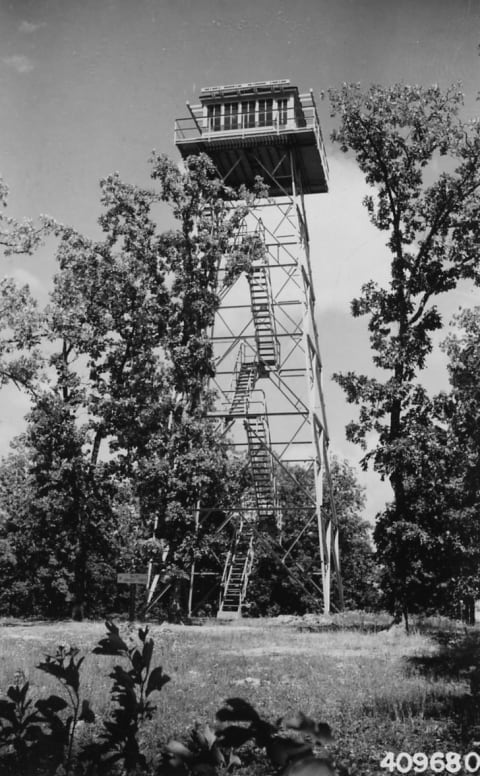
When the Department of Agriculture bought more than 3 million acres of land in Missouri and Arkansas in 1934 and 1935, various forestry professionals chimed in with their opinions about which Missourian deserved to be the namesake for the expansive soon-to-be national forest. Other contenders included World War I general John J. Pershing, poet Eugene Field, and pioneer Daniel Boone (who was actually born in Pennsylvania, though he died in Missouri).
More Articles About Mark Twain:
4. And Mark Twain also has a lake named after him.

A little over 30 miles from Hannibal, Missouri, the 18,600-acre Mark Twain Lake is Missouri’s seventh largest . The area not only boasts beaches, hiking trails, camping grounds, and other outdoor activities, it’s also home to the Mark Twain State Park, where you can visit the tiny two-room cabin where Clemens was born in 1835.
5. Mark Twain’s house in Hartford, Connecticut, has a whopping 25 rooms.
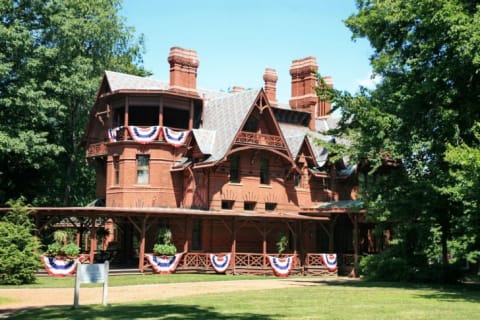
Mark Twain and his wife, Olivia Langdon Clemens, had three daughters and a son, Langdon, who died at just 19 months. The couple's daughters were:
- Olivia Susan "Susy" Clemens
- Clara Langdon Clemens
- Jane "Jean" Lampton Clemens
The family lived in their Hartford, Connecticut, mansion for 17 years, between 1874 and 1891. It was during that time that Clemens wrote his most famous books, including The Adventures of Tom Sawyer , Life on the Mississippi , The Prince and the Pauper , A Connecticut Yankee in King Arthur’s Court , and, of course, The Adventures of Huckleberry Finn .
6. Books weren’t Mark Twain’s only claim to fame.
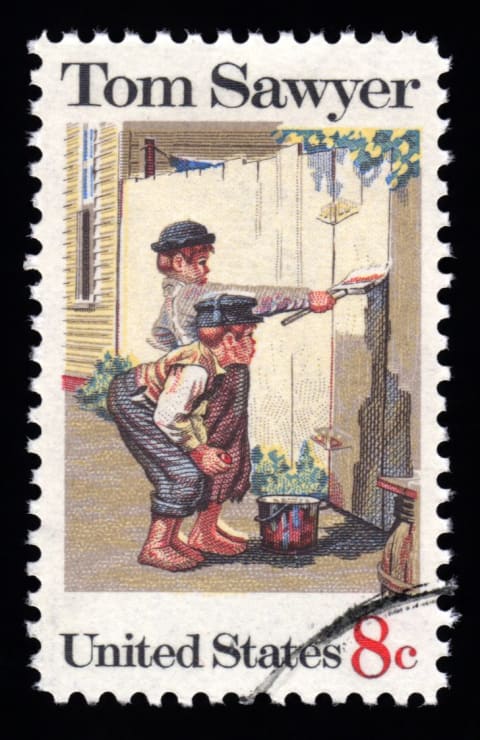
He also patented several inventions during his career, including: A convoluted trivia board game called Memory Builder , which required an extensive knowledge of figures, dates, and events across European and American history; a self-adhesive scrapbook that worked much like an envelope; and an adjustable, detachable garment clasp that was primarily intended for suspenders, but ended up being used mostly for bras.
Mark Twain Books You Should Know:
- The Innocents Abroad (1869)
- Roughing It (1872)
- The Gilded Age: A Tale of Today (1873)
- The Adventures of Tom Sawyer (1876)
- A Tramp Abroad (1880)
- The Prince and the Pauper (1881)
- Life on the Mississippi (1883)
- The Adventures of Huckleberry Finn (1884)
- A Connecticut Yankee in King Arthur's Court (1889)
- The American Claimant (1892)
- The Tragedy of Pudd'nhead Wilson (1894)
- Tom Sawyer Abroad (1894)
- Personal Recollections of Joan of Arc (1896)
- Tom Sawyer, Detective (1896)
- Following the Equator: A Journey Around the World (1897)
- A Horse's Tale (1906)
- The Mysterious Stranger (1916)
Funny Mark Twain Quotes
- “Yes, even I am dishonest. Not in many ways, but in some. Forty-one, I think it is.”
- “Wisdom teaches us that none but birds should go out early, and that not even birds should do it unless they are out of worms.”
- “I reverently believe that the Maker who made us all makes everything in New England but the weather.”
- “A use has been found for everything but snoring.”
- “There would be a power of fun in skating if you could do it with somebody else’s muscles.”
- “You ought never to take anything that don’t belong to you—if you cannot carry it off.”
- “Familiarity breeds contempt—and children.”
Mark Twain's Quotes About Love
- “Love seems the swiftest, but it is the slowest of all growths. No man or woman really knows what perfect love is until they have been married a quarter of a century.”
- “Love is a madness; if thwarted it develops fast.”
- “When you fish for love, bait with your heart, not your brain.”
- “The frankest and freest product of the human mind and heart is a love letter.”
Mark Twain's Quotes About Life and Death
- “Pity is for the living, envy is for the dead.”
- “Manifestly, dying is nothing to a really great and brave man.”
- “It is a solemn thought: dead, the noblest man’s meat is inferior to pork.”
- “Good friends, good books and a sleepy conscience: this is the ideal life.”
- “Let us endeavor so to live that when we come to die even the undertaker will be sorry.”
- “Only he who has seen better days and lives to see better days again knows their full value.”
- “Life: we laugh and laugh, then cry and cry, then feebler laugh, then die.”
- “When we remember we are all mad, the mysteries of life disappear and life stands explained.”
Mark Twain's Quotes About Travel
- “There is no unhappiness like the misery of sighting land (and work) again after a cheerful, careless voyage.”
- “Travel has no longer any charm for me. I have seen all the foreign countries I want to except heaven and hell and I have only a vague curiosity about one of those.”
- “Nothing so liberalizes a man and expands the kindly instincts that nature put in him as travel and contact with many kinds of people.”
- “Travel is fatal to prejudice, bigotry, and narrow-mindedness, and many of our people need it sorely on these accounts. Broad, wholesome, charitable views of men and things cannot be acquired by vegetating in one little corner of the earth all one’s lifetime.”

- History & Society
- Science & Tech
- Biographies
- Animals & Nature
- Geography & Travel
- Arts & Culture
- Games & Quizzes
- On This Day
- One Good Fact
- New Articles
- Lifestyles & Social Issues
- Philosophy & Religion
- Politics, Law & Government
- World History
- Health & Medicine
- Browse Biographies
- Birds, Reptiles & Other Vertebrates
- Bugs, Mollusks & Other Invertebrates
- Environment
- Fossils & Geologic Time
- Entertainment & Pop Culture
- Sports & Recreation
- Visual Arts
- Demystified
- Image Galleries
- Infographics
- Top Questions
- Britannica Kids
- Saving Earth
- Space Next 50
- Student Center

Mark Twain summary
Learn about the life and works of mark twain.

Mark Twain , orig. Samuel Langhorne Clemens , (born Nov. 30, 1835, Florida, Mo., U.S.—died April 21, 1910, Redding, Conn.), U.S. humorist, writer, and lecturer. He grew up in Hannibal, Mo., on the Mississippi River and was apprenticed in 1848 to a local printer. He received a riverboat pilot’s license in 1859 and later moved on to Nevada and California. In 1863 he took his pseudonym, the riverman’s term for water 2 fathoms (12 ft [3.7 m]) deep. In a California mining camp he heard the story that he first published in 1865 and made famous as the title story of his first book, The Celebrated Jumping Frog of Calaveras County and Other Sketches (1867). He traveled widely, using his travels as subject matter for lectures and books, from the humorous narratives The Innocents Abroad (1869) and Roughing It (1872) to Life on the Mississippi (1883), his reflections on being a riverboat captain. He won a worldwide audience for his adventure stories of boyhood, especially Tom Sawyer (1876) and Huckleberry Finn (1885), one of the masterpieces of American fiction. The satirical A Connecticut Yankee in King Arthur’s Court (1889) and increasingly grim works including Pudd’nhead Wilson (1894) and The Man Who Corrupted Hadleyburg (1899) followed. In the 1890s financial speculations bankrupted him. His eldest daughter died in 1896, his wife in 1904, and another daughter in 1909. He expressed his pessimism about human character in such late works as the posthumously published Letters from the Earth (1962).


- Huskie Link
- Anywhere Apps
- Huskies Get Hired
- Student Email
- Password Self-Service
Advanced Search
- Quick Links
- Photographs
- Illustrations & Pictures
- Songs & Sheet Music
- Manuscripts
- Articles & Clippings
- Video Recordings
- Nickels and Dimes: Dime Novels From the Collections of Johannsen and LeBlanc
- Lee Schreiner Sheet Music Collection
- 1962 World Science Fiction Collection
- 125th Anniversary Oral History Project
- Norther Yearbooks
- Northern Illinois
- Golden Anniversary Project
- NIU-DeKalb Community Black Oral History Project
- Peace Corps Training for Thailand
- W. W. Embree Collection
- World War I & II Poster Collection
- Browse all collections
- Southeast Asia Digital Library
- Latinx Oral History Project
- Ritzman Photo Collection
- Mark Twain's Mississippi
- Lincoln/Net
- Illinois During the Gilded Age
- American Archives
- Illinois During the Civil War
- Projects & Grants
- Get Involved
- Digitization Request
- Copyright & Usage
- Digitization Guidelines
- Collection Development Policy
- Digital Preservation Policy
- Digital Preservation Implementation Plan
Mark Twain's Mississippi
- Primary Source Materials
Mark Twain's Biography
by Gregg Camfield, PhD, University of California-Merced
On November 30, 1835, nearly thirty years before he took the pen name Mark Twain, Samuel Langhorne Clemens was born in Florida, Missouri, a hamlet some 130 miles north-northwest of St. Louis, and 30 miles inland from the Mississippi River. His father, John Marshall Clemens, had earlier that year moved the family there from Tennessee. In Tennessee, he had accumulated much land, a pair of slaves, a wife, and five children, but his efforts as a lawyer, storekeeper, and local politician did not yield the wealth he desired. Like many of his contemporaries, he decided that the way to a fortunate future was to move west. His brother-in-law, John Quarles, had established a farm in the new hamlet of Florida and invited John Marshall Clemens, his wife, Jane Lampton Clemens, and their brood of children to the new country.
Trained to be a country lawyer, John Marshall was no farmer, and even though Americans were extraordinarily litigious, it would take time (and denser population) to build a law practice that could support a family. He fell back on keeping store, and again did not thrive. Given that the river was where a merchant had access to markets, John Marshall moved his family to the as-yet-unincorporated town of Hannibal, about 30 miles east-northeast of Florida. There, too, his business ventures, in his dry-goods store, in his land dealings, even in his efforts to trade slaves, did not prosper. The family found itself slipping toward poverty — so desperate, in fact, that they had to sell off their furniture — before finally, John Marshall's political ambitions ended in his election to justice of the peace. While the fees he earned in this office were not enough to make the family's fortunes, they were the difference between poverty and a competence. Yet with fortunes finally looking up, John Marshall Clemens took ill and died in 1847. The remaining Clemens family (mother Jane, sister Pamela, and brothers Orion, Samuel, and Henry) had to make their way by hook and crook. Orion was already off in St. Louis, working as a journeyman printer. The wages he sent home kept the family afloat. Within a year, however, young Samuel could no longer afford the luxuries of childhood, school and play. Instead, he began his first apprenticeship, to Hannibal printer William Ament, publisher of the grandly named Missouri Courier.
In working for Ament, Sam learned about printing, the first mass production industry, almost as it had been practiced from the beginning. In a country print shop, a printer had to do everything from the editorial side, to type setting, to press-work, to distributing the finished product. There was no division of labor, and only hints of the industrial revolution. Yet brother Orion in St. Louis was working in a major print shop, as a compositor rather than as a printer. Orion, in keeping with craft guild principles, wanted to be his own master, so in 1851, he returned to Hannibal, bought one of the other Hannibal newspapers, the equally grandly named Western Union, and took on his younger brothers Samuel and Henry as his apprentices. He soon combined his struggling newspaper with the Hannibal Journal, but even a merger could not turn a local paper into a good living, especially for an owner whose politics were not fully congenial to Hannibal.
Neither younger brother much appreciated working for their quirky older brother. Orion fancied himself to be a new Benjamin Franklin, and used to badger his younger brothers with Franklin's aphorisms about industry, efficiency, temperance, and frugality. The frugality was imposed by the fact that such old-fashioned printing was not lucrative, even when it was a central part of the social fabric of the American small town. Young Samuel accepted the push toward industry and temperance, even as younger brother Henry rebelled by being lazy and sloppy in his work. Orion's response to Henry's poor work was often to put more on Samuel. Naturally, Sam came to resent his position, too. In 1853, he bolted, heading first for St. Louis to work as a typesetter, then heading out of the Mississippi Valley for the first time to work as a typesetter in a number of eastern cities, including New York and Philadelphia.
His correspondence home shows how much he accepted his responsibility to his mother, promising her a portion of his wages, yet his contact with the new industrial economy of the big cities prevented him from making much financial progress in his work. Demoralized that he was unable to make his fortune, he rejoined his family, which, in the interim, had also abandoned Hannibal. His sister had already moved to St. Louis when in 1851 she married William A. Moffet, a successful merchant. His brother Orion had sold his Hannibal print shop to move to Muscatine, Iowa, to free soil, where his abolitionist ideas were neither a threat to his livelihood nor his health. Samuel at this point did not oppose slavery; his attitudes were shaped primarily by those held by his Missouri neighbors, especially by his father and his Uncle Quarles. While his father never had many slaves, and in financial exigency had been forced to sell, he had helped uphold slavery in Missouri. His uncle was a farmer whose success depended not only on his own work, but on the labor of his slaves. In the years before he began his apprenticeship, Sam had spent many summers on the Quarles farm. But Orion's time in St. Louis had put him in touch with organized labor which, though often quite racist in its outlook, was opposed to slave labor as a system that undercut wages. When he moved to Iowa at the very end of 1853, he became active in anti-slavery politics, leading him ultimately to working for Lincoln's election in 1860.
Sam's return to the Mississippi Valley in late spring of 1854 was not a return to his childhood home. Now living in a free state, but with strong family ties to Missouri, his return to work for his brother was a stop-gap. Indeed, late in that year and early in 1855, he worked in St. Louis before returning to Muscatine. In 1856, he left home again, this time for a stint of typesetting in Cincinnati. Itinerant as always, Clemens was but briefly satisfied in Cincinnati, and when on his way home in 1857, he decided, instead, to change careers to become a riverboat pilot. In order to do so, he had to pay $500, half up front, with the balance to be paid from his first wages when the apprenticeship was over. (Multiply these numbers by 25 to find a rough equivalent to today's dollars.) He had to borrow the down payment from his brother-in-law. Young Sam did not have good role models for how to spend money, but given how poor he was, the amount he was willing to borrow says something about how much he wanted to become a riverboat pilot.
Fictionalized slightly, “Old Times on the Mississippi” tells the story of this apprenticeship. With the addition of the story of his successful efforts to get his younger brother, Henry, a job on a steamboat and his younger brother's death in a steamboat accident, found in chapters 18-20 of Life on the Mississippi, Twain's own account of his days as an apprentice on a steamboat, and his account of the social and political circumstances of steam boating, is one of the best accounts of river life ever written. But he left off the tale at the end of his apprenticeship, telling us next to nothing about his brief, successful career in boating. When fully licensed as a pilot in the St. Louis to New Orleans trade, Sam Clemens found regular and lucrative employment, enabling him not only to pay off his debts and help support his mother, but also giving him enough extra income to indulge himself.
I can "bank" in the neighborhood of $100 a month . . . and that will satisfy me for the present . . . . Bless me! . . . what respect Prosperity commands. Why, six months ago, I could enter the "Rooms," [of the Western Boatmen's Benevolent Association] and receive only the customary fraternal greeting — but now they say, "Why how are you, old fellow — when did you get in?" And the young pilots who used to tell me, patronisingly, that I could never learn the river, cannot keep from showing a little of their chagrin at seeing me so far ahead of them. . . . I must confess that when I go to pay my dues, I rather like to let the d—d rascals get a glimpse of a hundred dollar bill peeping out from amongst notes of smaller dimensions.
Not surprisingly, one of his chief indulgences was to speculate in commodities, buying and shipping them as he went up and down the river. True to family form, he lost money.
But his newfound wealth and the company he began to keep helped him leave his mother's and brother's world emotionally as well as physically. He was a chief player in an industry that was so modern and cosmopolitan that it figures in such stories as T.B. Thorpe's “The Big Bear of Arkansas” and Herman Melville's The Confidence Man, as a symbol of America: of its politics, its trade, its industry, its cultural and ethnic diversity, of its inexorable changes. His letters from the period show him indulging his restless spirit in taking advantage of the entertainments of two of America's great cities. From things as innocent as learning to dance, which according to his mother's strict religion encouraged sin, to learning to drink and curse, which were culturally normal but coming under regular attack in an evangelical and reformist age, Clemens explored behavior and attitudes that were new to him. And the powers of observation required of him as a pilot certainly helped him when he turned to journalism and then to writing novels, sketches, and stories.
Had the Civil War not interrupted the river trade, Samuel Clemens might have spent his life as a pilot, writing no more than an occasional newspaper squib. Clemens was not a hothead on either side, in part because his livelihood depended on commerce between the North and the South up and down the great riverway. In the election of 1860, Sam Clemens voted his bread and butter. Spurning both the Democratic Party and the new Republican Party, Clemens voted for the Constitutional Union Party's ticket of Bell and Everett. But when the war began, Clemens's vague leanings toward states' rights and slavery came out. First, he holed up with his sister's family in St. Louis, fearing that he would be impressed as a pilot for Union transport or gun boats. Then, in the late spring of 1861, he answered the call of the states' rights leaning Missouri Governor, C.F. Jackson, to form militias to “repel the invader.” Technically, Missouri never joined the Confederacy, so Clemens's brief stint as an irregular soldier cannot be classified as time as a Confederate soldier, but given that Clemens and his fellow militia-men knew full well that they were to fight against the troops of the United States Army, such semantic distinctions are unimportant. What is important, is that Clemens was not confident enough of his actions to let his brother Orion know of them.
The Civil War radically transformed the nation and many of the lives in it, and that was almost as true for Sam Clemens as it was for so many others. Sam Clemens planned to pass the few months the War was expected to last out West, living off his savings while prospecting for silver and gold. As the War dragged on, his savings ran out. He did not strike it rich, and facing poverty again, he returned to the printing industry, this time on the editorial side. In part because he was a talented writer and in part because he was well connected politically, he was hired by the Virginia City Territorial Enterprise to be a reporter. There he served yet another apprenticeship, this time in literary work. There he first used his famous pen name, “Mark Twain,” derived from his days on the River. The call “Mark Twain” means, literally, “at this point, two,” meaning that at a given point, the river is two fathoms (twelve feet) deep. This was the usual depth for safe passage for a Mississippi River steamboat. (Though in Virginia City, some of his friends interpreted “Mark Twain” to stand for Clemens's tendency to order two drinks at a time and mark them on his bar tab.) There he began to work as a roving reporter, and the reputation he earned in Nevada expanded until newspapers from California to New York sent him all over the world to report on politics, the arts, fashion, commerce — anything that would entertain or inform readers. His life as a reporter and then as a belletristic writer led him to make his home in Nevada, California, Washington, D.C., New York, Connecticut, England, Germany, France, and Italy, but never again in the Mississippi Valley.
While the War started a chain of events that removed Samuel Clemens physically from the Mississippi Valley, it did not remove him imaginatively. If anything, the War also forced Clemens to rethink what he believed. As he put it in a letter to his Missouri friend Jacob H. Burrough in a 1 November 1876 letter,
As you describe me I can picture myself as I was, twenty-two years of age. The portrait is correct. You think I have grown some; upon my word there was room for it. You have described a callow fool, a self-sufficient ass, a mere human tumble-bug . . . . Ignorance, intolerance, egotism, self-assertion, opaque perception, dense and pitiful chuckle-headedness . . . . That is what I was at 19-20; & that is what the average Southerner is at 60 to-day.
The process that began in 1860 did not end until he died in 1910, and in his imagination he revisited the Mississippi Valley incessantly, in one literary work after another, including The Gilded Age (1871) “Old Times on the Mississippi” (1874), The Adventures of Tom Sawyer (1876), Life on the Mississippi (1883), Adventures of Huckleberry Finn (1884), Pudd'nhead Wilson and Those Extraordinary Twins (1893), a series of sequels to the Tom and Huck stories, and in “Chapters from My Autobiography.”
- World Biography
Mark Twain Biography
Born: November 30, 1835 Florida, Missouri Died: April 21, 1910 Redding, Connecticut American writer and humorist
Mark Twain, American humorist (comic writer) and novelist, captured a world audience with stories of boyhood adventure and with commentary on man's faults that is humorous even while it probes, often bitterly, the roots of human behavior.
Childhood along the Mississippi
Mark Twain was born Samuel Langhorne Clemens on November 30, 1835, in the frontier village of Florida, Missouri. He spent his boyhood in nearby Hannibal, on the banks of the Mississippi River, observing its busy life, fascinated by its romance, but chilled by the violence and bloodshed it bred. Clemens was eleven years old when his lawyer father died. In order to help the family earn money, the young Clemens began working as a store clerk and a delivery boy. He also began working as an apprentice (working to learn a trade), then a compositor (a person who sets type), with local printers, contributing occasional small pieces to local newspapers. At seventeen his comic sketch "The Dandy Frightening the Squatter" was published by a sportsmen's magazine in Boston, Massachusetts.
In 1853 Clemens began wandering as a journeyman printer to St. Louis, Missouri; Chicago, Illinois; New York, New York; and Philadelphia, Pennsylvania; settling briefly with his brother, Orion, in Iowa before setting out at twenty-two years old to make his fortune, he hoped, beside the lush banks of the Amazon River in South America. Instead, traveling down the Mississippi River, he became a steamboat river pilot until the outbreak of the Civil War (1861–65), when Northern forces clashed with those of the South over slavery and secession (the South's desire to leave the Union).
Western years
In 1861 Clemens traveled to Nevada, where he invested carelessly in timber and silver mining. He settled down to newspaper work in Virginia City, until his reckless pen and redheaded temper brought him into conflict with local authorities; it seemed profitable to escape to California. Meanwhile he had adopted the pen name of Mark Twain, a riverman's term for water that is just safe enough for navigation.
In 1865, Twain began to write a short story, The Jumping Frog of Calaveras County, which first brought him national attention. Most of his western writing was hastily, often carelessly, done and he later did little to preserve it.
Traveling correspondent
In 1865 the Sacramento Union commissioned Mark Twain to report on a new excursion service to Hawaii. His accounts as published in the newspaper provided the basis for his first successful lectures and years later were collected in Letters from the Sandwich Islands (1938) and Letters from Honolulu (1939). His travel accounts were so well received that he was contracted in 1866 to become a traveling correspondent for the Alta California; he would circle the globe, writing letters.
In 1870 Twain married Olivia Langdon. After a brief residence in upstate New York as an editor and part owner of the Buffalo Express, he moved to Hartford, Connecticut, where he lived for twenty years; there three daughters were born, and prosperity as a writer and lecturer (in England in 1872 and 1873) seemed guaranteed. Roughing It (1872) recounted Mark Twain's travels to Nevada and reprinted some of the Sandwich Island letters.
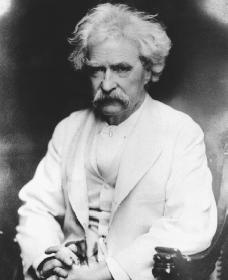
"Tom" and "Huck"
Twain's Tom Sawyer, better organized than Huckleberry Finn, is a narrative of innocent boyhood play that accidentally discovers evil as Tom and Huck witness a murder by Injun Joe in a graveyard at midnight. The boys run away, are thought dead, but turn up at their own funeral. Tom and Huck decide to seek out the murderer and the reward offered for his capture. It is Tom and his sweetheart who, while lost in a cave, discover the hiding place of Injun Joe. Though the townspeople unwittingly seal the murderer in the cave, they close the entrance only to keep adventuresome boys like Tom out of future trouble. In the end, it is innocent play and boyish adventuring which really triumph.
Huckleberry Finn is considered by many to be Mark Twain's finest creation. Huck lacks Tom's imagination; he is a simple boy with little education. One measure of his character is a proneness to deceit, which seems instinctive, a trait shared by other wild things and relating him to nature—in opposition to Tom's tradition-grounded, book-learned, imaginative deceptions. The Adventures of Huckleberry Finn, a loosely strung series of adventures, can be viewed as the story of a quest for freedom and an escape from what society requires in exchange for success. Joined in flight by a black companion, Jim, who seeks freedom from slavery, Huck discovers that the Mississippi is peaceful (though he is found to be only partially correct) but that the world along its shores is full of trickery, including his own, and by cruelty and murder. When the raft on which he and Jim are floating down the river is invaded by two criminals, Huck first becomes their assistant in swindles but is finally the agent of their exposure.
Whatever its faults, Twain's Huckleberry Finn is a classic. Variously interpreted, it is often thought to suggest more than it reveals, speaking of what man has done to confuse himself about his right relation to nature. It can also be thought of as a treatment of man's failures in dealing with his fellows and of the corruption that man's only escape is in flight, perhaps even from himself. Yet it is also an apparently artless story of adventure and escape so simply and directly told that novelist Ernest Hemingway (c.1899–1961) once said that all American literature begins with this book.
Last writings
After a series of unsuccessful business ventures in Europe, Twain returned to the United States in 1900. His writings grew increasingly bitter, especially after his wife's death in 1905. The Man That Corrupted Hadleyburg (1900) exposed corruption in a small, typical American town. Eve's Diary (1906), written partly in memory of his wife, showed a man saved from bungling only through the influence of a good woman.
In 1906 Twain began to dictate his autobiography to Albert B. Paine, recording scattered memories without any particular order. Portions from it were published in periodicals later that year. With the income from the excerpts of his autobiography, he built a large house in Redding, Connecticut, which he named Stormfield. There, after several trips to Bermuda to improve his declining health, he died on April 21, 1910.
For More Information
Kaplan, Justin. Mr. Clemens and Mark Twain: A Biography. New York: Simon and Schuster, 1966.
Krauth, Leland. Proper Mark Twain. Athens: University of Georgia Press, 1999.
Paine, Albert Bigelow. Mark Twain, A Biography: The Personal and Literary Life of Samuel Langhorne Clemens. New York: Harper & Bros., 1912. Reprint, Philadelphia: Chelsea House, 1997.
Twain, Mark. The Autobiography of Mark Twain. New York: Harper, 1959. Reprint, New York: Perennial Classics, 2000.
Ward, Geoffrey C., and Dayton Duncan. Mark Twain. New York: Knopf, 2001.
Wecter, Dixon. Sam Clemens of Hannibal. Boston: Houghton Mifflin, 1952. Reprint, New York: AMS Press, 1979.
User Contributions:
Comment about this article, ask questions, or add new information about this topic:.
World History Edu
- Mark Twain / Renowned Writers
Mark Twain: Biography, Achievements, Major Works, & Facts
by World History Edu · October 6, 2021

Mark Twain – biography and achievements
This American humorist, novelist and lecturer produced some of the most important works in the history of modern literature. With more than twenty novels to his name, many of them well-received as well, Mark Twain thus became an influential public figure and one of the greatest American writers of all time. This notion is supported by American writer and 1949 Nobel Prize in Literature winner William Cuthbert Faulkner (1897-1962), who described Twain as “the Father of American literature”.
World History Edu takes a quick look at the early life, education, career, achievements, and major facts about Mark Twain.
Mark Twain: Fast Facts
Real name : Samuel Langhorne Clemens
Date of birth : November 30, 1835
Birthplace : Florida, Missouri, U.S.
Died : April 21, 1910
Place of death : Redding, Connecticut
Buried : Woodlawn Cemetery, Elmira, New York, United States
Parents : John Marshall Clemens and Jane Clemens
Siblings : Six, including Orion Clemens and Henry Clemens
Wife : Olivia Langdon (married in 1870; died in 1904)
Children : Langdon, Susy, Clara and Jean
Notable Works: The Gilded Age: A Tale of Today , The Adventures of Tom Sawyer , The Prince and the Pauper , Tom Sawyer Abroad
Awards : Hall of Fame for Great Americans (1920)
Occupation : Humorist, novelist, public moralist, political philosopher, travel writer, publisher, and lecturer
What is Mark Twain most famous for?
The Florida, Missouri-born humorist and novelist is most famous for works such as the The Adventures of Tom Sawyer (1876) and The Prince and the Pauper (1881).
Twain is also famous for penning the Adventures of Huckleberry Finn (1884), a book which is sometimes called “The Great American Novel”. The book is a sequel to his other famous book The Adventures of Tom Sawyer (1876).
With works such as “The Celebrated Jumping Frog of Calaveras County” (1865), Mark Twain, born Samuel Langhorne Clemens, was also known for his mastery of spoken language, wit and satire.
How was Mark Twain educated?
His schooling ended when he was in the fifth grade because he took up an apprenticeship training at a printer’s shop. He also trained as a typesetter at his older brother Orion’s newspaper, the Hannibal Journal.
The lack of an advance formal education did nothing to inhibit his literary prowess as he educated himself in public libraries in Missouri.
What was Mark Twain’s childhood like?

Samuel Langhorne Clemens , age 15, better known by his pen name Mark Twain
Mark Twain was of English, Cornish and Scottish descent. He had six siblings; however only three made it past childhood. The three were Orion (1824-1897), Henry (1838-1858), and Pamela (1827-1904).
He was born in Florida, Missouri, but he spent much of his childhood in Hannibal, Missouri, a port town that inspired the fictional place St. Petersburg in The Adventures of Tom Sawyer and later the Adventures of Huckleberry Finn.
What did Mark Twain write?
Mark Twain drew a lot of his material from his childhood experiences in Hannibal, Missouri. His inclination to infuse slavery into books like the Adventures of Huckleberry Finn stemmed from the fact that slavery was legal in Missouri during his childhood.
Mark Twain is famously known for his published works The Gilded Age: A Tale of Today , The Adventures of Tom Sawyer , and The Prince and the Pauper . He was born Samuel Langhorne Clemens on November 30, 1835 in Florida, Missouri, United States.
Birth and early life

Mark Twain’s Old Times on the Mississippi (1875) affectionately recounts his childhood memories in Hannibal.
Born Samuel Langhorne Clemens, Mark Twain grew up with six siblings in Florida, Missouri. When he was around four years old, his family’s financial woes forced them to immigrate to Hannibal , a lively port town along the Mississippi River in the state of Missouri.
Twain, who was born two months prematurely, struggled for the first decade or so in his life. Many home therapies were used by his mother to give the young Twain some semblance of a normal life. His sickly nature meant that he was treated with somewhat of a kid’s glove. He is said to have had a knack for being mischievous child.
His mother Jane Clemens had the greatest impact on him as a child. He most likely got his sense of humor from his mother, not his father John Marshall Clemens (1798-1847). His father was quite a stern and serious parent, often times not displaying any kind of affection to the young Clemens or his siblings.
After moving to Hannibal, John Clemens set up a store; he would later go on to become a justice of the peace (i.e. a local magistrate). Hannibal was not very kind to the Clemens as their financial woes continued. His family penned a great deal of hope on a 70,000-acre land in Tennessee, hoping it would be their ticket to stable lifestyle. As Twain would later write, the land ended up being a bad investment like many other speculative ventures of his father’s.
As a child, Twain’s active imagination was evident right from the get go. He and his friends would act out stories from many fabled adventures, including Robin Hood. Often times, he would visit the labyrinthine McDowell’s Cave and go swimming in the river near Glasscock’s Island. In his book Adventures of Huckleberry Finn , the island becomes Jackson’s Island.
During the summer holidays, Twain would spend time at his uncle John Quarles’ farm in Florida, Missouri, where he have a great deal of fun with his cousins. As kids, they would listen to the captivating stories told by a slave called Uncle Daniel, a man who Twain transformed into the character Jim in Adventures of Huckleberry Finn.

His childhood experiences with friend Tom Blankenship was the inspiration for his book character Huckleberry Finn.
Tragedies suffered during his childhood
It was not all fun and sunshine during his childhood. Twain had his fair share of personal losses. One of his siblings, Margaret, succumbed to a disease when Twain was still toddler. His brother Benjamin died when Twain was around seven years old. Then, at the age of eight, he acquired measles during the epidemic. His childhood was also marred by the cholera epidemic that claimed the lives of over 20 people in the town. Perhaps the biggest tragedy of his childhood came in 1847, when his father, John Clemens, passed away due to pneumonia.
The death of his father further exacerbated the family’s financial problems. The family was forced to sell a great deal of their possessions, including the only slave, Jennie, they owned. Yes! Mark Twain’s family, who lived in the slave state of Missouri, owned a slave. It was the mid-1850s; slavery hadn’t been abolished at time. As a kid, Twain was told by his elders that slaves were chattel that God sanctioned for people to own. In his adult years, Twain struggled to with the guilt and shame of his family’s possession of a slave.
The port town of Hannibal, Missouri, also had its fair share of violent activities that left a scar on the mind of the young Clemens. He once saw a man gunned down a Hannibal merchant. He was also shocked by level of abuse slaves in Missouri endured at the hands of their owners. One time, he and his friends, while playing in the river, found a dead slave body floating in the river.
Authors and works that influenced Mark Twain
Growing up, Samuel Clemens was influenced by writers such as Scottish poet and novelist Sir Walter Scott (1771-1832) and American author and novelist James Fenimore Cooper (1789-1851). The latter author was most famous for writing novels of frontier adventure, including The Pioneers (1823) and The Pathfinder (1840).
During his writing career, Mark Twain, being an excellent raconteur, penned down the fond stories he had as a child in Hannibal, Missouri. Such stories appeared in his 1875 book “Old times on the Mississippi”. Twain also credits the port town’s buzzing and colorful nature for shaping his imagination.
The labyrinthine McDowell’s Cave in Hannibal was featured in Mark Twain’s classic The Adventures of Tom Sawyer as McDougal’s Cave.

What jobs did Mark Twain have?
Before taking up writing as a full time job, Mark Twain worked in a variety of jobs. In the years after his father’s death, he began working to supplement his family’s meager income. In 1848, he was employed as a printer’s apprentice for the Missouri Courier. Then in 1851, he was employed as typesetter in his brother Orion’s Hannibal newspaper, the Journal. It was probably around this time that Twain began to hone his talents in writing. He would sometimes write sketches and articles for the journal. His sketch titled “The Dandy Frightening the Squatter” (1852) received quite a number of followers as it was carried in many local newspapers.
Mark Twain’s older brother Orion purchased the Hannibal Journal in 1850. Twain got employed in the newspaper as a typesetter. He also worked as an editor when his brother was not available.
Towards his late teens, he resigned from his brother’s journal and pursued his own endeavors, including being a typesetter in St. Louis in 1853. He worked for a number of printing businesses in the east, including in Philadelphia, Washington, D.C., and New York City. He worked as a laborer for many years, until he was almost 40, when according to him got up one day and entered into the writing profession proper.
Twain spent a great number of years travelling through many states in the East. His journeys enriched his literary mind, allowing him to gain a very wide perspective of the world that he lived in.
Time as a steamboat pilot
In 1857, he became an apprentice for a riverboat captain called Horace Bixby. He is said to have paid $500 in apprentice fee. He studied the Mississippi River and desired nothing than to acquire a pilot license.

Working with other veteran pilots, Samuel Clemens quickly learned the trade. He took quite a lot of pride in being a steamboat pilot. Back the steamboat pilot was very well respected, even more than the captain. Steamboat pilots earned good wages in addition to the respect they received from the society.
Twain saw the job as one that gave him a great deal of freedom and self-sufficiency, believing that the job also instilled in him discipline, a sense of purpose and direction. He was a member of the Western Boatman’s Benevolent Association. By 1859, he had received his pilot’s license.
Mark Twain’s wife and daughters

Mark Twain’s wife – Olivia Langdon in 1869
While traveling through Europe in the late 1860s, he met Charles Langdon, who later introduced Twain to his sister Olivia Langdon. Mark Twain noted that he fell head over heels for Olivia, who was the daughter of a businessman from Elmira, New York. The two tied the knot in February 1870.
With some bit of help from his wife’s father, the couple were able to buy one-third interest in the Express of Buffalo, New York.

Mark Twain’s daughters (L-R): Susy, Clara, and Jean
After making their home in Buffalo, New York, Mark Twain and Olivia Langdon had four children, one son and three daughters: Langdon, Susy (1872-1896), Clara (1874-1962), and Jean (1880-1909). Langdon died (of diphtheria) in 1872, before turning two.
Twain’s marriage to Olivia Langdon spanned for 34 years until she died in 1904.
Personal tragedies suffered by Mark Twain
Mark Twain’s losses weren’t only financial. The acclaimed writer suffered a series of personal losses in the last decade of the 19 th century and the early 20 th century.
His daughter Susy died of spinal meningitis in 1896. His daughter’s death was a huge blow to him and his wife, who was plagued by an awful sickness by then. Twain committed himself to his work in an attempt to mitigate the pain. That same year, his other daughter Jean was diagnosed with epilepsy. The family visited many European countries looking for a remedy.
On June 5, 1904, his wife died, sending him into an even deeper depression. His book Eve’s Diary (1906) – which talks about the love between Adam and Eve – was in honor of his deceased wife.
On December 24, 1909, his daughter Jean succumbed to complications from her epilepsy. Twain wrote the book “The Death of Jean” (1911) to honor her. About six months prior to Jean’s death, his very close friend Henry Rogers died.
All of those personal tragedies made him sad and lonely in his final few years.
Mark Twain during the American Civil War
He worked on the steamboat until the outbreak of the American Civil War in 1861. For a brief period, he served in the Confederate Army, however, he later deserted, stating that he was not made to be a soldier.
“The Private History of a Campaign That Failed” – a sketch in 1885 – a fictional memoir – his time in the Confederate Missouri State Guard in Marion County, Missouri – group of inexperienced militiamen called the Marion Rangers
Mark Twain and his brother Orion fled from Hannibal to the Nevada Territory. His brother was a Republican and supported Abraham Lincoln ’s presidential bid. For that, Orion Clemens was appointed territorial secretary of Nevada.
While in Nevada Territory, he took trading in silver, timber and gold in the mining town of Virginia City, Nevada. Success was a hard to come by as a miner. With the help of a newspaper editor Joseph Goodman, he became a reporter at the Virginia City Territorial Enterprise. Many of the stories he covered the city’s endemic corruption and moral decadence. He performed his job diligently, even at the risk to his life.
It was around this time that he started going by the pen name “Mark Twain”. He also grew into his literary profession. Some of his articles appeared outside the territory, in places like New York.
In a brash act of immaturity, he challenged the editor of a San Francisco newspaper to a duel. After realizing how reckless his action was, he fled the city out of fear. In the mid-1860s, Twain headed to San Francisco to work as a full-time reporter for the Call. He also worked with the Golden Era.
“The Celebrated Jumping Frog of Calaveras County” (1865)
One of Mark Twain’s most famous short stories, “The Celebrated Jumping Frog of Calaveras County” (1865), was inspired by his experiences after he had fled San Francisco to Tuolumne foothills in the U.S. state of California. The story was a huge success, bringing the humorist critical acclaim.
In 1866, he took up a job with the Sacramento Union as a reporter. He work in Hawaii (the Sandwich Islands) would later serve as important material for his first lecture tour.
In 1867, he worked as a traveling correspondent for the San Francisco Alta California. The newspaper paid for his trip to Europe and the Holy Land on the condition that he writes travel stories for the newspaper. Those letters are what turned into the travel book The Innocents Abroad (1869) (also known as The New Pilgrims’ Progress ), which proved to be a huge success.

Mark Twain, born Samuel L. Clemens, attained worldwide acclaim with his very popular books. He was also famed for his lecture tour, which fetched considerable amount of money, especially in his later years.
Mark Twain and Nikola Tesla
The writer and novelist Mark Twain was said to have been a big fan of technology and science. Out of this curiosity, he formed a strong friendship with inventor and futurist Nikola Tesla . Twain even got to patent a number of inventions that had made, including a detachable straps for garments.
Twain’s association with Nikola Tesla rubbed off a bit in the novelist’s works. For example, in his 1889 novel A Connecticut Yankee in King Arthur’s Court , Twain writes about a fictional American time traveler who finds himself in the age of King Arthur and tries to help the people with modern technology.
Twain was also an acquaintance of Thomas Edison, one of Tesla’s arch rivals in the scientific world. In 1909, Edison, the inventor of the light bulb, visited Twain at his home in Connecticut and took a motion picture of him.
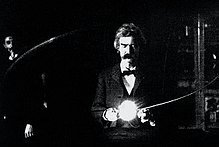
Samuel Clemens, aka Mark Twain, in the laboratory of Nikola Tesla, early 1894
Mark Twain’s publishing house
In 1884, Twain established his own publishing company. He partnered with nephew and businessman Charles L. Webster. The publishing company, which was known as Charles L. Webster and Company, experienced severe financial problems and then went bust in 1894. In spite of his determined efforts to keep the company afloat using his own personal money, the publishing house still folded up.
The publishing house still made history with its first two publications: Mark Twain’s Adventures of Huckleberry Finn (1885) and former US president Ulysses S. Grant ’s memoir – the Personal Memoirs of Ulysses S. Grant (1885). Both books received a lot of critical acclaim. Twain’s publication of U.S. Grant’s memoir helped lift the former U.S. general and POTUS out of a financial misery. After the death of Grant, Twain presented a whopping $450,000 to Julia Grant, the wife of Grant.
Read More: 10 Military Achievements of U.S. Grant

Mark Twain and James W. Paige
An avid admirer of science and technology, Mark Twain invested heavily in the Paige Compositor, an invention by James W. Paige (1842-1917). For someone who was once a typesetter, Twain bought into the invention that was made to make human typesetter obsolete.
Unfortunately, technical problems in the design caused the machine to be a huge flop on the market. Mark Twain invested about a quarter of a million USD into the machine that never turned a profit. The horrible venture marked the beginning of the writer’s financial woes. By 1891, Twain had given up on the project. The financial crisis of 1893 further compounded his mounting debt problem, causing him to file for personal bankruptcy.
With the help of Wall Street business executive and financier Henry Huttleston Rogers, Twain was able to turn things around. His world lecture tour and book sales helped him to pay all his debts.
Note: In today’s dollar, the amount ($300,000) Mark Twain spent on the Paige Compositor is the equivalent of about $ 9.5 million.
Most famous Mark Twain works

American humorist and novelist Mark Twain authored more than 20 novels | Image: Twain, age 31
Mark Twain is undoubtedly the greatest humorist in modern American literature. He once described humor as his “strongest suit”. The author believed that humor is a call to literature of a low order. The following are the most famous works by Mark Twain:
- The Celebrated Jumping Frog of Calaveras County and Other Sketches (1867)
- Roughing It (1872) – a semi-autobiographical travel book by Mark Twain
- The Gilded Age (1873) – a book that exposed the financial corruption in the U.S.
- A True Story (1874) – published in the Atlantic Monthly.
- The Adventures of Tom Sawyer (1876) – Mark Twain described it as a “hymn” to his childhood. The book, which is full of nostalgia, follows the story of a mischievous boy. The book is still in print, as both young and old readers can relate to it.
- Adventures of Huckleberry Finn (1884) – Mark Twain began writing this book in 1876. The novel, a sequel to Tom Sawyer, follows the story of Huck Finn, a character from the book Tom Sawyer.
- The Prince and the Pauper (1881)
- Life on the Mississippi (1883)
- Personal Recollections of Joan of Arc (1895/96)
- Following the Equator (1897)
- What Is Man? ( 1906)
- King Leopold’s Soliloquy (1905)
World lecture tour
In 1895, Mark Twain went on a world lecture tour in an attempt to raise money to pay his creditors. The writer visited places in Canada, New Zealand, India, South Africa and Australia, among others.
He was able to author a book primarily using the experiences of his tour in India. The book was titled Following the Equator (1897).

When and how did Mark Twain die?
Mark Twain was born shortly after the passing of Halley’s Comet. Interestingly, he died a day after the comet passed by the Earth again. The humorist had stated that he was bound to “go out with it”.
On April 21, 1910, Mark Twain died in his Stormfield home in Redding, Connecticut. The humorist and novelist was aged 74, and was survived by his daughter Clara.
Then-U.S. president William Howard Taft sent his heartfelt condolences to Twain’s surviving relatives. The president paid homage to his contribution American literature, heaping praise on his works for giving enormous pleasure to millions of people across the world.
The last work he was working on – “Etiquette for the Afterlife: Advice to Paine” – was posthumously published in 1995. It is a short humorous sketch.

Mark Twain was buried at a family plot in Elmira, New York, alongside his wife, his son, and two daughters. He left an estate valued at almost half a million USD (about $13 million in today’s dollars). | Image: Twain and his wife are buried side by side in Elmira’s Woodlawn Cemetery
Mark Twain’s real name

Origin of Mark Twain’s pen name | Other pen names of Samuel Clemens (aka Mark Twain) included Quintius Curtius Snodgrass, Thomas Jefferson Snodgrass and Josh, among others. In the end, he picked Mark Twain as his pseudonym.
Unbeknownst to many people Mark Twain is actually the pen name of Samuel Clemens. But why did Samuel Clemens choose the pen name Mark Twain?
Before settling on “Mark Twain”, the writer used a number of different pseudonyms, including “Josh” and “Thomas Jefferson Snodgrass”. The first time he used a pen name was in the early 1850s when he signed a sketch in his brother’s newspaper “W. Epaminondas Adrastus Perkins”.
The name “Mark Twain” emerged during his years working as a steamboat pilot on the Mississippi. Mark twain is the nautical term for water found to be two fathoms – i.e. 12 feet (3.7 meters) deep. Thus mark means “measure”, while twain means “ two”.
Mark Twain also acknowledged that his famous pen name was used by Captain Isaiah Sellers before he adopted in his literary profession.
Mark Twain quotes
The following are 5 major quotes by Mark Twain, the writer who is commonly regarded as the greatest humorist in the history of the United States.

More Mark Twain Facts
The following are six more facts about Mark Twain:

Image: Twain in his gown (scarlet with grey sleeves and facings) for his D.Litt. degree, awarded to him by Oxford University in 1907
- The asteroid 2362 is named after Mark Twain.
- William Dean Howells, his friend and author and critic, described him as the “sole, incomparable, the Lincoln of our literature” in the book My Mark Twain (1910).
- Ernest Hemingway writes in The Green Hills of Africa (1935), “All modern American literature comes from one book by Mark Twain called Huckleberry Finn”.
- In January 1901, he became the vice-president of the Anti-Imperialist League of New York – January 1901
- He received Honorary degrees from Yale University in 1901; the University of Missouri in 1902 (honorary Doctor of Laws); and Oxford University in 1907.
- He convinced his younger brother Henry Clemens to join the steamboat job. Unfortunately, Henry died on June 21, 1858 after getting severely injured in an explosion on the steamboat. Twain would forever feel guilty for the death of his brother Henry.
Tags: American novelists Hannibal-Missouri Mark Twain Missouri-U.S. Samuel Clemens The Gilded Age Tom Sawyer
You may also like...

Wole Soyinka: Biography, Political Activism, Major Plays, Nobel Prize, & Achievements
May 3, 2021

William Shakespeare: Biography, Major Plays & Death
June 5, 2019

20 Surprising Facts about Maya Angelou
July 7, 2020
Leave a Reply Cancel reply
Your email address will not be published. Required fields are marked *
Save my name, email, and website in this browser for the next time I comment.
- Next story Stephen King: Biography, Books, and Major Achievements and Awards
- Previous story Henry III of England: History, Family Tree, Reign, Achievements, & Death
- Popular Posts
- Recent Posts

Mobutu Sese Seko

Journey to the West: Origin Story, Themes & Symbolism of the Famed Classical Chinese Novel

Ivan Pavlov – Biography, Major Works & Accomplishments

Queen of the Dead in Ancient Egypt

History of Islam: How and When Did Islam Begin?

Greatest African Leaders of all Time

Queen Elizabeth II: 10 Major Achievements

Donald Trump’s Educational Background

Donald Trump: 10 Most Significant Achievements

8 Most Important Achievements of John F. Kennedy

Odin in Norse Mythology: Origin Story, Meaning and Symbols

Ragnar Lothbrok – History, Facts & Legendary Achievements

9 Great Achievements of Queen Victoria

Most Ruthless African Dictators of All Time

12 Most Influential Presidents of the United States

Greek God Hermes: Myths, Powers and Early Portrayals

Kamala Harris: 10 Major Achievements

Kwame Nkrumah: History, Major Facts & 10 Memorable Achievements

8 Major Achievements of Rosa Parks

How did Captain James Cook die?

Trail of Tears: Story, Death Count & Facts

5 Great Accomplishments of Ancient Greece

Most Famous Pharaohs of Egypt

The Exact Relationship between Elizabeth II and Elizabeth I

How and when was Morse Code Invented?
- Adolf Hitler Alexander the Great American Civil War Ancient Egyptian gods Ancient Egyptian religion Apollo Athena Athens Black history Carthage China Civil Rights Movement Cold War Constantine the Great Constantinople Egypt England France Hera Horus India Isis John Adams Julius Caesar Loki Medieval History Military Generals Military History Napoleon Bonaparte Nobel Peace Prize Odin Osiris Ottoman Empire Pan-Africanism Queen Elizabeth I Religion Set (Seth) Soviet Union Thor Timeline Turkey Women’s History World War I World War II Zeus
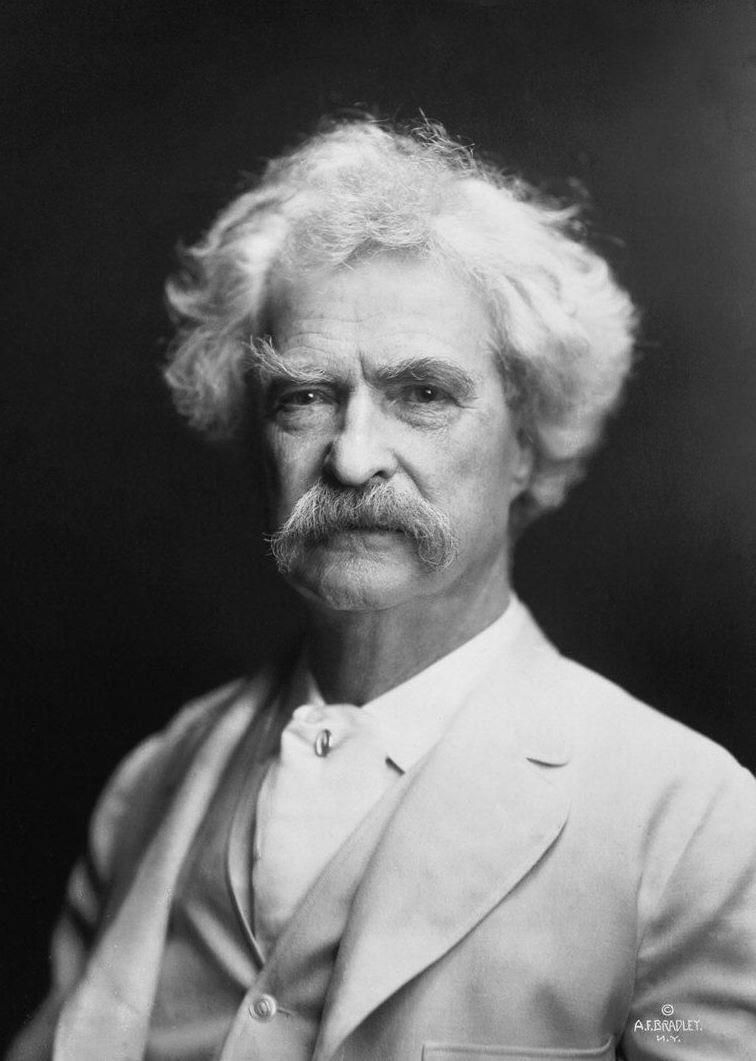
Mark Twain aka Samuel Langhorne Clemens (1835-1910) was one of the best known American writers, and is considerd the greatest humorist USA had produced. William Faulkner called him "the father of American literature". He wrote many novels, short stories, travel stories and essays. His best known novels include The Adventures of Tom Sawyer (1876) and its sequel, the Adventures of Huckleberry Finn (1884), often called "The Great American Novel". Other well known novels include The Prince and the Pauper (1881) and A Connecticut Yankee in King Arthur's Court (1889).
Twain was was born in Florida, Missouri and raised in Hannibal, Missouri, which later provided the setting for Tom Sawyer and Huckleberry Finn. He worked as a typesetter, journalist, and later became a riverboat pilot on the Mississippi River. His first important humorous story, "The Celebrated Jumping Frog of Calaveras County", was published in 1865. His last work was the "Autobiography of Mark Twain" dictated in the last years of his life.
Twain was fascinated with science and scientific inquiry. He developed a close and lasting friendship with Nikola Tesla, and the two spent much time together in Tesla's laboratory.
Twain's wit and satire, earned praise from critics and peers, and he was a friend to presidents, artists, industrialists, and European royalty.
Read more about Mark Twain on Wikipedia.
| American Florida, Missouri, United States Redding, CT, United States Novels; Humor/Satire; Short Stories; Plays; Essays; Letters Family: Born November 30, 1835, in Florida, MO; died of heart disease, April 21, 1910, in Redding, CT; buried in Elmira, NY; son of John Marshall (a lawyer) and Jane (Lampton) Clemens; married Olivia Langdon, February 2, 1870 (died, 1904); children: Langdon, Olivia Susan, Clara, Jean Lampton. Military/Wartime Service: Wartime service:Confederate Army during Civil War; became second lieutenant. Writer. Worked as printer's apprentice and typesetter in Hannibal, MO, 1847-50; associated with 1850-52; typesetter, 1853-57; apprentice riverboat pilot, 1857-59; riverboat pilot, 1859-60; secretary and government worker in Nevada, 1860-62; miner, 1862; Virginia City, NV, reporter (sometimes under pseudonym Mark Twain), 1862-64; San Francisco, reporter under Twain pseudonym, 1864; Sacramento, CA, correspondent under Twain pseudonym, 1866; San Francisco, correspondent under Twain pseudonym, 1866-69; editor under Twain pseudonym, 1869-71. Owner of Charles L. Webster & Co. (publishers), early 1. BY THE AUTHOR: illustrated by Augustus Hoppin and others, American Publishing, 1873, Twain's portion published separately as edited by Charles Nelder, Doubleday, 1965. illustrated by True Williams, American Publishing (Hartford, CT), 1876. Chatto & Windus (London), 1881, Osg(Boston), 1882. illustrated by Edward Windsor Kemble, Chatto & Windus, 1884, Webster (New York Ci 1885. illustrated by Dan Beard, Webster, 1889, published as Chatto & Windus, 1889. (adapted from the play by Twain and William Dean Howells; also see below), Webster, 1892. illustrated by Dan Beard, Webster, 1894. Chatto & Windus, 1894, expanded as illustrated by E. V. Du Mond, Harper (New York City), 1896. Harper, 1909. illustrated by N. C. Wyeth, edited by Albert Bigelow Paine and Frederick A. Duneka, Harper, 1916. (unfinished novel), edited by Franklin R. Rogers, New York Public Library, 1963. edited by John Paul, C. H. Webb (New York City), 1867. J. C. Hotten, 1871. J. C. Hotten, c. 1871. Routledge (London), 1872. illustrated by R. T. Sperry, American News, 1874, expanded as American Publishing, 1876. Webster, 1892. Webster, 1893. Chatto & Windus, 1896. Harper, 1900, revised edition, Chatto & Windus, 1900. illustrated by Lucius Hitchcock, Harper, 1902. illustrated by W. T. Smedley, Harper, 1904. (also see below), illustrated by F. Strothmann, Harper, 1904. (also see below), illustrated by Lester Ralph, Harper, 1906. Harper, 1906. illustrated by Lucius Hitchcock, Harper, 1907. Boni & Liveright (New York City), 1919. Howell, 1926. Funk & Wagnall, 1967. (contains excerpts from and ), American Heritage, 1971. Volume 1: edited by Edgar M. Branch and Robert H. Hirst, University of California Press, 1979. illustrated by Joe McDermott, Creative Education (Mankatom, MN), 1986. (five-act), produced in New York City, 1874. produced in Washington, DC, 1877. Buttonmaker Press (Omaha), 1986. (adapted from the novel by Twain and Warner), 1873; author, with William Dean Howells, of 1887. illustrated by True Williams, American Publishing, 1869, published in two volumes as and Hotten (London), 1870. (also see below), Routledge (London), 1872. Routledge, 1872, revised edition (includes ), American Publishing, 1872. Rose-Belford, 1878, revised as Slote, Woodman, 1878. illustrated by Twain and others, American Publishing, 1880, excerpt published as (also see below). American Publishing, 1897, published as Chatto & Windus,7. edited by Albert Bigelow Paine, Harper, 1923. edited by Daniel Morley McKelthan, University of Oklahoma Press, 1958. illustrated by Fred Brenner, Orion Press, 1963. Harper, 1897. Mutual Book Co., 1900. P. R. Warren, 1905. Harper, 1905. American Publishing, 1906. De Vinne Press, 1906, revised as Harper, 1917. Harper, 1907. Harper, 1909. Harper, 1918. Harper, 1934. (two volumes), edited by Albert Bigelow Paine, Harper, 1917. edited by Cyril Clemens, Meador, 1932. edited by Theodore Hornberger, University of Texas Press, 1941. edited by Dixon Wecter, Harper, 1949. edited by Dixon Wecter, Huntington Library, 1949. edited by Thomas H. English, Emory University, 1953. (two volumes), edited by Henry Nash Smith and William M. Gibson, Belknap Press, 1960. edited by Lewis Leary, Columbia University Press, 1961. edited by Bernard De Voto, preface by Henry Nash Smith, 1962. edited by A. Grove Day, Appleton-Century, 1966. edited and with an introduction by Hamlin Hill, University of California Press, 1967. edited by Leary, University of California Press, 1969. Belford, 1876, reprinted as Ward, Lock & Tyler, 1877, revised as Lerner, 1975. (two volumes), edited by Albert Bigelow Paine, Harper, 1924, edited as one volume by Charles Neider, Harper, 1959. edited by G. Ezra Dane, Grabhorn, 1937. edited by Franklin Walker, Fields, 1938. edited by Edgar M. Branch, Mark Twain Association of America, 1942. edited by Henry Nash Smith, University of California Press, 1957. edited by Bruce R. McElderry, Jr., Scholars' Facsimiles and Reprints, 1961. edited by Bernard Taper, McGraw, 1963. edited by Edgar M. Branch, University of California Press, 1969. Harper, 1935. edited by Cyril Clemens, Stokes, 1935. edited by Bernard De Voto, Viking, 1946. edited by Martion B. Fried, Salisbury Club, 1961. edited by Walter Blair, Houghton, 1962. edited by Justin Kaplan, Harper, 1967. edited by Paul Baender, University of California Press, 1973. Running Press, 1976. edited by Paul Fatout, University of Iowa Press, 1976. Doubleday, 1977. edited by Fatout, Purdue University Press, 1978. edited by John S. Tuckey, University of California Press, 1979. arranged and edited by William L. McLinn, foreward by Louis J. Budd, and introduction by Robert McAfee Brown, Hunt Pub. Co. (Dubuque, IA), 1983. Sheldon, 1871. J. C. Hotten, 1872. [and] J. R. Osgood, 1877. [Cleveland], 1880. Osgood, 1882, published as Chatto & Windus, 1882. illustrated by E. W. Kemble, C. L. Webster, 1888. edited by F. A. Nast, Harper, 1910. (two volumes), edited by Albert Bigelow Paine, Harper, 1924. edited by Charles Honce, Pascal Covici, 1928. edited by Albert Bigelow Paine, Harper, 1935. edited by Franklin Walker and G. Ezra Dane, Knopf (New York City), 1940. Prairie Press, 1952. edited by William G. Gibson, University of California Press, 1969. University of California Press, Volume 1: edited by Frederick Anderson, Michael B. Frank, and Kenneth M. Sanderson, 1975, Volume 2: edited by Anderson, Lin Salamo, and Bernard L. Stein, Volume 3: edited by Robert Pack Browning, Frank, and Salamo, 1979. edited by Sidney E. Berger, Norton, 1980. drawings by John Groth, Harper, 1984. edited with introduction by Charles Neider, Harper, 1984. edited with introduction by Paul M. Zall, University of Tennessee Press, 1985. introduction by Ken Chowder, Chronicle Books (San Francisco), 1991. edited by R. Kent Rasmussen, Contemporary Books (Chicago), 1995. edited by Howard G. Baetzhold and Joseph B. McCullough, University of Georgia Press (Athens), 1995. selected by Brain Collins, Columbia University Press (New York City), 1996. and (twenty-five volumes), American Publishing, 1899-1907. (twenty-five volumes), edited by Albert Bigelow Paine, Harper, 1906, expanded edition (thirty-seven volumes), Wells, 1922-1925. selections an introduction by Michael Patrick Hearn, illustrated by True Williams, Avenel Books (New York City), 1979. edited by Victor Doyno, foreward by Leslie Fiedler, Prometheus Books (Buffalo, NY), 1983. edited with introduction by Charles Neider, Doubleday (Garden City, NY), 1985. edited with introduction by Neider, Doubleday, 1987. Library of America (New York City), 1992. edited by Jason S. Roberts, Barnes & Noblew York City), 1993. opening remarks by Kurt Vonnegut Jr., edited by Lawrence Teacher, Sweetwater Press (Birmingham, AL), 1997. was adapted as a motion picture titled in 1931 by Paramount, in 1939 and again in 1960 by Metro-Goldwyn-Mayer (MGM), and in 1974 by United Artists; was adapted as in 1930 by Paramount, and as motion picture of the same title in 1938 by Selznick International and in 1973 by United Artists; was adapted as the film Paramount, 1939; was adapted as the film in 1931 by Twentieth Century-Fox, and as in 1949 by Paramount; was adapted as motion pictures of the same title in 1937 by Warner Bros., and in 1969 by Childhood Productions; was adapted as a film titled in 1978 by Warner Bros.; was adapted as a film of the same title in 1965 by Saloon Productions; was adapted as a film titled in 1948 by Columbia. Among the many stagings of Twain's works are and some of Twain's writings have also been adapted as radio plays; has also been staged as a musical. Twain's own life inspired filmed by Warner Bros. in 1944, and such stage productions as April 22, 1910.* The Gale Group, 1999. Contemporary Authors |

A Short Biography of Mark Twain
Mark Twain died on 21 st April 1910 at the age of 74.
Mark Twain’s Writing Style
Southwestern humor, the divided nature of twain’s work.
For example, in the novel The Adventures of Huckleberry Finn, in the descriptions of the adventures of the King and the Duke, the readers observe Twain’s criticism while showing the predatory nature of a man who exploits the people in their most vulnerable conditions. By using the artless narrator, Twain describes how Wilks’ family falls prey to two scoundrels after the death of their father. The slaves are immediately sold by the king. Huck observes the grief of the family at the loss of their servants as:
Distinguishing Characteristics
Works of mark twain.
Writers Abroad
Biography: mark twain.
Samuel Langhorne Clemens (November 30, 1835 – April 21, 1910), better known by his pen name Mark Twain , was an American author and humorist. He wrote The Adventures of Tom Sawyer (1876) and its sequel, Adventures of Huckleberry Finn (1885), the latter often called “The Great American Novel.”
Twain grew up in Hannibal, Missouri, which provided the setting for Huckleberry Finn and Tom Sawyer . After an apprenticeship with a printer, he worked as a typesetter and contributed articles to the newspaper of his older brother, Orion Clemens. He later became a riverboat pilot on the Mississippi River before heading west to join Orion in Nevada. He referred humorously to his singular lack of success at mining, turning to journalism for the Virginia City Territorial Enterprise . In 1865, his humorous story, “The Celebrated Jumping Frog of Calaveras County,” was published, based on a story he heard at Angels Hotel in Angels Camp, California, where he had spent some time as a miner. The short story brought international attention, and was even translated into classic Greek. His wit and satire, in prose and in speech, earned praise from critics and peers, and he was a friend to presidents, artists, industrialists, and European royalty.
Twain was born shortly after a visit by Halley’s Comet, and he predicted that he would “go out with it”, too. He died the day after the comet returned. He was lauded as the “greatest American humorist of his age,” and William Faulkner called Twain “the father of American literature.”
| Mark Twain | |
|---|---|
| Born | Samuel Langhorne Clemens November 30, 1835 Florida, Missouri, U.S. |
| Died | April 21, 1910 (aged 74) Redding, Connecticut, U.S. |
| Pen name | Mark Twain |
| Occupation | Writer, lecturer |
| Nationality | American |
| Notable works | , |
| Spouse | Olivia Langdon Clemens( 1870; 1904) |
| Children | Langdon, Susy, Clara, Jean |
| Signature | |
Twain began his career writing light, humorous verse, but evolved into a chronicler of the vanities, hypocrisies and murderous acts of mankind. At mid-career, with Huckleberry Finn , he combined rich humor, sturdy narrative and social criticism. Twain was a master at rendering colloquial speech and helped to create and popularize a distinctive American literature built on American themes and language. Many of Twain’s works have been suppressed at times for various reasons. Adventures of Huckleberry Finn has been repeatedly restricted in American high schools.
A complete bibliography of his works is nearly impossible to compile because of the vast number of pieces written by Twain (often in obscure newspapers) and his use of several different pen names. Additionally, a large portion of his speeches and lectures have been lost or were not written down; thus, the collection of Twain’s works is an ongoing process. Researchers rediscovered published material by Twain as recently as 1995 and 2015.
View Mark Twain’s full biography on Wikipedia.
- Mark Twain. Provided by : Wikipedia. Located at : https://en.wikipedia.org/wiki/Mark_Twain . License : CC BY-SA: Attribution-ShareAlike
- Image of Mark Twain. Authored by : Matthew Brady. Located at : https://commons.wikimedia.org/wiki/File:Mark_Twain,_Brady-Handy_photo_portrait,_Feb_7,_1871,_cropped.jpg . License : Public Domain: No Known Copyright

- Occupation: Author
- Born: November 30, 1835 in Florida, Missouri
- Died: April 21, 1910 in Redding, Connecticut
- Best known for: Writing the books The Adventures of Tom Sawyer and The Adventures of Huckleberry Finn
- "It is better to keep your mouth closed and let people think you are a fool than to open it and remove all doubt."
- "The best way to cheer yourself up is to try to cheer somebody else up."
- "The secret of getting ahead is getting started."
- "Get your facts first, then you can distort them as you please."
- "Kindness is the language the deaf can hear and the blind can see."
- "If you tell the truth, you don't have to remember anything."
- Twain married Olivia Langdon in 1870. They had three daughters and one son.
- He joined a Confederate militia for two weeks at the start of the Civil War, but quit before he had to fight.
- He was a strong supporter of putting an end to slavery . He also supported women's rights and suffrage .
- The Adventures of Huckleberry Finn is sometimes referred to as "The Great American Novel."
- He claimed to have foreseen his brother's death in a dream a month before his brother died.
- Listen to a recorded reading of this page:
| |

Table of content
- Short stories
Mark Twain (real name Samuel Langhorne Clemens), November 30, 1835 – April 21, 1910, was an American author and humorist. He wrote The Adventures of Tom Sawyer (1876) and its sequel, Adventures of Huckleberry Finn (1885), the latter often called “The Great American Novel”.
Twain grew up in Hannibal, Missouri, which provided the setting for Huckleberry Finn and Tom Sawyer. After an apprenticeship with a printer, he worked as a typesetter and contributed articles to the newspaper of his older brother, Orion Clemens. He later became a riverboat pilot on the Mississippi River before heading west to join Orion in Nevada. He referred humorously to his singular lack of success at mining, turning to journalism for the Virginia City Territorial Enterprise. In 1865, his humorous story, “The Celebrated Jumping Frog of Calaveras County,” was published, based on a story he heard at Angels Hotel in Angels Camp, California, where he had spent some time as a miner. The short story brought international attention, and was even translated into classic Greek. His wit and satire, in prose and in speech, earned praise from critics and peers, and he was a friend to presidents, artists, industrialists, and European royalty.
Twain was born shortly after a visit by Halley’s Comet, and he predicted that he would “go out with it”, too. He died the day after the comet returned. He was lauded as the “greatest American humorist of his age,” and William Faulkner called Twain “the father of American literature.”
Novels by Mark Twain

A Connecticut Yankee in King Arthur’s Court
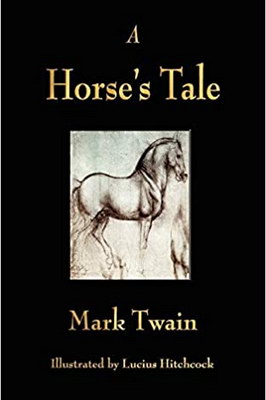
A Horse’s Tale

A Tramp Abroad

Personal Recollections of Joan of Arc
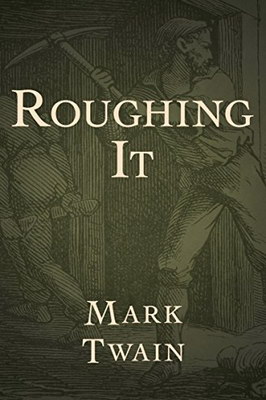
Roughing It
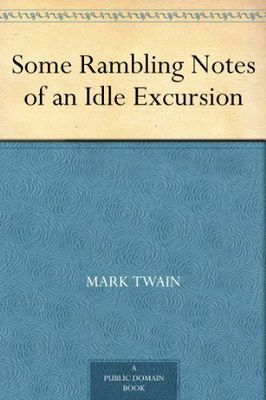
Some Rambling Notes Of An Idle Excursion
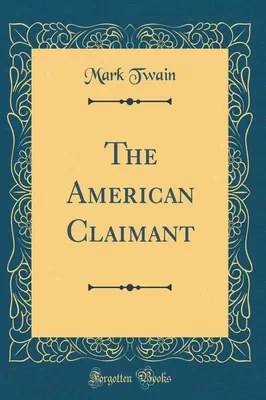
The American Claimant
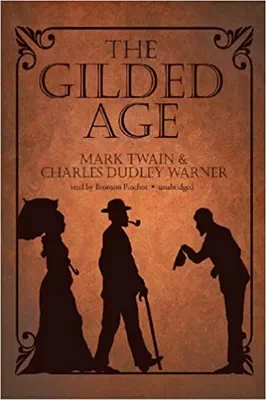
The Gilded Age: A Tale of Today
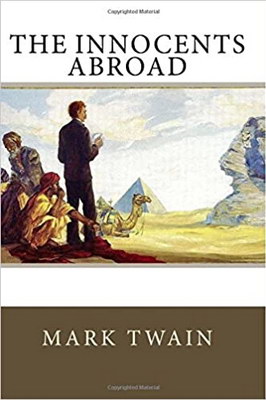
The Innocents Abroad
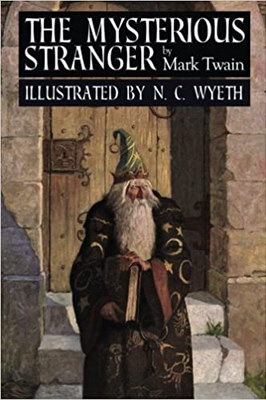
The Mysterious Stranger
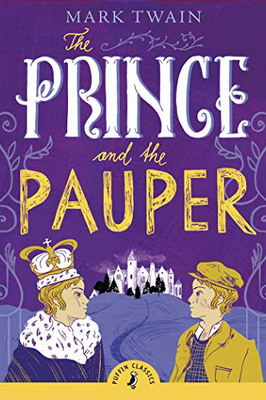
The Prince and the Pauper

The Tragedy of Pudd’nhead Wilson

Those Extraordinary Twins
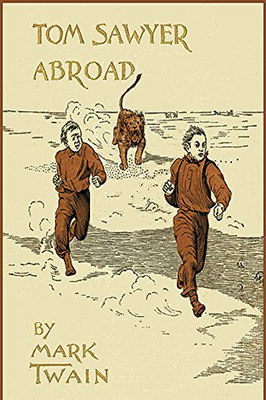
Tom Sawyer Abroad

Tom Sawyer, Detective
Plays by mark twain.

Encounter With An Interviewer
Essays by mark twain.
- A Scrap Of Curious History
- A Simplified Alphabet
- As Concerns Interpreting The Deity
- At the Shrine of St. Wagner
- Concerning Tobacco
- Essays on Paul Bourget
- Fenimore Cooper’s Literary Offences
- How to Make History Dates Stick
- In Defense of Harriet Shelley
- Is Shakespeare Dead?
- On The Decay Of The Art Of Lying
- Taming The Bicycle
- The Death of Jean
- The Memorable Assassination
- The Turning Point of My Life
- What Is Man?
- William Dean Howells
Short stories by Mark Twain
- “After” Jenkins
- “Party Cries” In Ireland
- $30,000 Bequest, The
- A Burlesque Biography
- A Cure for the Blues
- A Dog’s Tale
- A Fashion Item
- A Fine Old Man
- A Ghost Story
- A Helpless Situation
- A Mysterious Visit
- A Telephonic Conversation
- About Barbers
- About Play-Acting
- Advice to Little Girls
- Amended Obituaries
- Answers To Correspondents
- At The Appetite-Cure
- Aurelia’s Unfortunate Young Man
- Cannibalism In The Cars
- Captain Stormfield’s Visit to Heaven
- Christian Science and the book of Mrs. Eddy
- Concerning Chambermaids
- Diplomatic Pay and Clothes
- Disgraceful Persecution Of A Boy
- Edward Mills And George Benton: A Tale
- English as She is Taught
- Eve’s Diary
- Experience Of The McWilliamses With Membranous Croup
- Extracts From Adam’s Diary
- First Interview With Artemus Ward
- From the ‘London Times’ of 1904
- General Washington’s Negro Body-Servant
- Honored As A Curiosity
- How I Edited An Agricultural Paper Once
- How The Author Was Sold In Newark
- How To Tell A Story
- Hunting The Deceitful Turkey
- In Memoriam – Olivia Susan Clemens
- Information Wanted
- Introduction to “The New Guide of the Conversation in Portuguese and English”
- Is He Living or Is He Dead?
- Italian with Grammar
- Italian without a Master
- John Chinaman In New York
- Johnny Greer
- Journalism In Tennessee
- Lionizing Murderers
- Mr. Bloke’s Item
- My Bloody Massacre
- My Boyhood Dreams
- My Debut as a Literary Person
- My First Lie, and How I Got Out of It
- My First Literary Venture
- Paris Notes
- Petition Concerning Copyright
- Political Economy
- Portrait of King William III
- Post-mortem Poetry
- Punch, Brothers, Punch
- Riley-Newspaper Correspondent
- Running For Governor
- Some Learned Fables, For Good Old Boys And Girls
- Speech At The Scottish Banquet In London
- Speech On Accident Insurance
- Speech On The Weather
- Stolen White Elephant, The
- Switzerland, the Cradle of Liberty
- The Californian’s Tale
- The Capitoline Venus
- The Captain’s Story
- The Case Of George Fisher
- The Curious Dream
- The Danger of Lying in Bed
- The Esquimaux Maiden’s Romance
- The Facts Concerning the Recent Carnival of Crime in Connecticut
- The Facts Concerning The Recent Resignation
- The Five Boons Of Life
- The Judge’s “Spirited Woman”
- The Jumping Frog
- The Killing of Julius Caesar “Localized”
- The Late Benjamin Franklin
- The Loves of Alonzo Fitz Clarence and Rosannah Ethelton
- The McWilliamses And The Burglar Alarm
- The Office Bore
- The Petrified Man
- The Science vs Luck
- The Scriptural Panoramist
- The Story Of The Bad Little Boy
- The Story Of The Good Little Boy
- The Undertaker’s Chat
- The Widow’s Protest
- To Raise Poultry
- To the Above Old People
- Travelling with a Reformer
- Was It Heaven? Or Hell?
- Wit Inspirations Of The “Two-Year-Olds”
Poems by Mark Twain
- A Man Hired By John Smith And Co
- A Sweltering Day In Australia
- O Lord, Our Father
- Ode To Stephen Dowling Bots, Dec’D
- The Aged Pilot Man
- Those Annual Bills
- Warm Summer Sun
Short Stories

A lie can travel halfway around the world while the truth is putting on its shoes.
And as Ernest Hemingway wisely observed: "All modern American literature comes from one book by Mark Twain called Huckleberry Finn ." "

Biography of Mark Twain
Christened as Samuel Langhorne Clemens, the man who would call himself Mark Twain was born on November 30, 1835 in the small river town of Florida, Missouri, just 200 miles from Indian Territory. The sixth child of John Marshall Clemens and Jane Lampton, Twain lived in Florida, Missouri until the age of four, at which time his family relocated to the town of Hannibal in hopes of improving their living situation.
By lineage, Twain was a Southerner, as both of his parents' families hailed from Virginia. The slaveholding community of Hannibal, a river town with a population of 2000, provided a mix of rugged frontier life and the Southern tradition, a lifestyle that influenced Twain's later writings, including the Adventures of Tom Sawyer . Few black slaves actually resided in Hannibal, and the small farms on the delta were no comparison to the typical Southern plantation. In Hannibal, blacks were mostly held as household servants rather than field workers, but were still under the obligations of slavery.
In his youth, Twain was a mischievous boy, the prototype of his character, Tom Sawyer. Though he was plagued by poor health in his early years, by age nine he had already learned to smoke, led a small band of pranksters, and had developed an aversion to school. Twain's formal schooling ended after age 12, because his father passed away in March of that year. He became an apprentice in a printer's shop and then worked under his brother, Orion, at the Hannibal Journal , where he quickly became immersed in the newspaper trade. Rising to the role of sub-editor, Twain indulged in the frontier humor that flourished in journalism at the time: tall tales, satirical pranks, and jokes.
However, over the next few years, Twain found himself unable to save any wages and grew restless. He decided to leave Hannibal in June of 1853 and accepted a position in St. Louis. Soon after, rather than settling in St. Louis, Twain proceeded to travel back and forth between New York, Philadelphia, Washington, and Iowa, working as a journalist. After his wanderings, Twain ultimately switched professions, realizing an old boyhood dream of becoming a river pilot.
Under the apprenticeship of Horace Bixby, pilot of the Paul Jones , Mark Twain became a licensed river pilot at the age of 24. Earning a high salary navigating the river waters, Twain was entertained by his work, and enjoyed his traveling lifestyle. In 1861, with the beginning of the Civil War, Twain's piloting days came to an end.
After returning home to Hannibal, Twain learned that military companies were being organized to assist Governor Jackson, and he enlisted as a Confederate soldier. Within a short period, he abandoned the cause, deserted the military, and along with thousands of other men avoiding the draft, moved West. On his way to Nevada, twelve years after the Gold Rush, Twain's primary intentions were to strike it rich mining for silver and gold. After realizing the impossibility of this dream, Twain once again picked up his pen and began to write.
Twain joined the staff of the Virginia City Territorial Enterprise , and became an established reporter/humorist. In 1863, he adopted the pseudonym Mark Twain, derived from a river pilot term describing safe navigating conditions. In 1869 he published his first book of travel letters entitled Innocents Abroad . The book was criticized widely and discouraged Twain from pursuing a literary career. In the years that followed, Twain published various articles, traveled the lecture circuits, and relocated between San Francisco, New York, and Missouri. During this time he also met Olivia Langdon, whom he married on February 2, 1870. In November of the same year, their first son, Langdon Clemens, was born prematurely.
The Clemens family quickly fell into debt. However, when over 67,000 copies of Innocents Abroad sold within its first year, the American Publishing Company asked Twain for another book. Upon Olivia's request, the couple moved to the domicile town of Hartford, Connecticut, where Twain composed Roughing It , which documented the post-Gold Rush mining epoch and was published in 1872.
In March of 1872, Twain's daughter Susan Olivia was born, and the family appeared prosperous. Unfortunately, their son Langdon soon came down with diphtheria and died. Twain was torn apart by his son's death, and blamed himself. Moreover, Roughing It was only mildly successful, which added to the family's hardships.
After traveling to Europe for a lecture series, Twain experienced a turning point in his career. Twain's newest novel, The Gilded Age , written in collaboration with Charles Dudley Warner, was published in 1873. The novel is about the 1800s era of corruption and exploitation at the expense of public welfare. The Gilded Age was Twain's first extended work of fiction and marked him in the literary world as an author rather than a journalist.
After the broad success of The Gilded Age , Twain began a period of full-time writing. In 1880, his third daughter, Jean, was born. By the time Twain reached age fifty, he was already considered a successful writer and businessman. His popularity sky-rocketed with the publications of The Adventures of Tom Sawyer (1876), The Prince and the Pauper (1882), and The Adventures of Huckleberry Finn (1885). By 1885, Twain was considered one the greatest character writers in the literary community.
Twain died on April 21, 1910, having survived his children Langdon, Susan and Jean as well as his wife, Olivia. In his lifetime, he became a distinguished member of the literati, and was honored by Yale, the University of Missouri, and Oxford with literary degrees. With his death, many volumes of his letters, articles, and fables were published, including: The Letters of Quintas Curtius Snodgrass (1946); Simon Wheeler, Detective (1963); The Works of Mark Twain: What is Man? and Other Philosophical Writings (1973); and Mark Twain's Notebooks and Journals (1975-79). Perhaps more than any other classic American writer, Mark Twain is seen as a phenomenal author, but also as a personality that defined an era.
Other works include:
Punch, Brothers, Punch! and Other Stories (1878)
A Tramp Abroad (1880)
The Stolen White Elephant (1882)
Life on the Mississippi (1883)
A Connecticut Yankee in King Arthur's Court (1889)
Merry Tales (1892)
Personal Recollections of Joan of Arc (1896)
How to Tell a Story and Other Essays (1897)
A Dog's Tale (1904)
Is Shakespeare Dead? (1909)

Study Guides on Works by Mark Twain
The adventures of huckleberry finn mark twain.
Throughout the twentieth century, The Adventures of Huckleberry Finn has become famous not only as one of Twain's greatest achievements, but also as a highly controversial piece of literature. In certain Southern states, the novel was banned due...
- Study Guide
- Lesson Plan
The Adventures of Tom Sawyer Mark Twain
With the publishing of the Adventures of Tom Sawyer, Mark Twain introduced the two immortal characters of Tom and Huckleberry to the "Hall of Fame" of American literature, as well as re-invented the traditional frontier tale. Written around 1870,...
The Californian’s Tale Mark Twain
In a very symbolic, but also rather literal way, Mark Twain was engaging in a bit of gold prospecting himself when he penned “The Californian’s Tale.” While Twain seemed to have an unerring knack for putting his finger directly on the pulse of...
The Celebrated Jumping Frog of Calaveras County Mark Twain
Mark Twain’s short story “The Celebrated Jumping Frog of Calaveras County” was a huge success when it was published on November 18, 1865 in the New York Saturday Press . It established Twain’s reputation as a humorist with a great ear for regional...
Connecticut Yankee in King Arthur's Court Mark Twain
A Connecticut Yankee in King Arthur's Court was the last of Twain's novels written during the apex of his career. As a work it shows his more mature writing, hinting at some of the cynical and dark themes that he would obsess over in his final...
The Diaries of Adam & Eve Mark Twain
The Diaries of Adam & Eve were, at first, two separate short stories written by American author, Mark Twain. The first one, Adam's Diary, was first published in 1893 and the second one, Eve's Diary, in 1906. The two tales were reunited in...
The Man That Corrupted Hadleyburg Mark Twain
The Man That Corrupted Hadleyburg is considered a short story rather than a novel, but many argue about this, as the work is too big to be a short story, and too small to be called a novel. Thus, The Man That Corrupted Hadleyburg stands on the...
Mark Twain: Essays Mark Twain
Mark Twain is one of the most famous figures in American literature, and is known for his novels like The Adventures of Tom Sawyer and The Adventures of Huckleberry Finn. What is not as widely known about him is the surprising amount of essays...
The Notorious Jumping Frog of Calaveras County Mark Twain
“The Notorious Jumping Frog of Calaveras County” was originally published in the Saturday Press in 1865 before appearing two years later in Mark Twain’s Sketches, New and Old. The story can present something of a prickly problem for old-fashioned...
The Prince and the Pauper Mark Twain
The Prince and the Pauper is a book written by American classic writer Mark Twain published in 1881. First published in Canada, it is the first historical fiction book written by Mark Twain. The book is set in the early 1500s, where readers follow...
Pudd'nhead Wilson Mark Twain
Pudd'nhead Wilson was written during Mark Twain's "pessimistic period." At the time, Twain was living in Italy, attempting to recover from his recent bankruptcy. To raise some funds, he sold the rights to the novel to Century Magazine for $6,500....
Roughing It Mark Twain
Mark Twain asserted that his literary hybrid Roughing It was nothing more than a simple personal narrative, absent any intent to present that account as history or philosophy. Well, Mark Twain said a lot of things, some of them not to be trusted....
- What's New?

Mark Twain (1835–1910) was an American writer most famous for his children’s books ‘The Adventures of Tom Sawyer’ and ‘The Adventures of Huckleberry Finn’. Born Samuel Clemens, he used the pen name Mark Twain for his writing career. Here you can find out more about this ‘father of American literature’ whose charm and wit won him many friends.
- Samuel Clemens was born shortly after the appearance of Halley’s Comet in 1835. He believed that he would ‘go out with it’ as well. Halley’s Comet appears about once every 75 years, and Samuel died the day after its return in 1910.
- The pen name Mark Twain comes from a riverboat term measuring the water’s depth. A ‘mark’ stood for a fathom or six feet, while ‘twain’ meant two. If a man called out ‘Mark Twain’, it meant the water was 12 feet deep and safe for riverboats of the time.
Favourite Mark Twain Quotes
“The secret of getting ahead is getting started.”
“The two most important days in your life are the day you are born and the day you find out why.”
“If you love what you do you’ll never work another day in your life.”
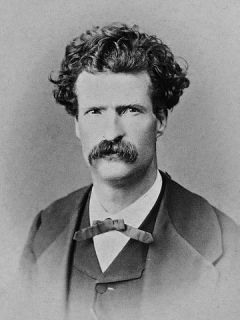
A Short Biography of Mark Twain
Mark Twain was born Samuel Clemens in 1835 in Florida, Missouri, USA. He was the sixth of seven children born to John Clemens, a lawyer, and his wife Jane, although three of Samuel’s siblings died in childhood.
When Samuel was four, the family moved to Hannibal, a town on the Mississippi River. Samuel loved to watch the riverboats and dreamed of being a riverboat pilot . Many of his stories were inspired by his adventures in Hannibal.
When Samuel was 11, his father died. To support his family, Samuel became a printer’s apprentice at the Missouri Courier. He learnt a lot about writing and used public libraries in the evenings to educate himself. Later, Samuel worked as a typesetter for the Western Union, his brother Orion’s newspaper. Samuel created articles and sketches for the paper, and became known for his humour .
At 17, Samuel left Hannibal and found print work in St Louis, New York, Philadelphia and Cincinnati. Then in 1857, he returned to study for two years to become a riverboat pilot.
But 1861 saw the end of Samuel’s river days once the Civil War started. He moved west to join the Confederate Army, although he left before fighting began. After working briefly as a miner, he became a reporter for the Territorial Enterprise in Virginia City, Nevada, and began writing short stories under the name Mark Twain. These funny tales were full of adventure. Mark’s first popular story – ‘The Celebrated Jumping Frog of Calaveras County’ –was published in 1865. It received international acclaim and soon Mark was one of the most famous American celebrities of his day. He was asked to write his first (and best-selling) book ‘The Innocents Abroad’ (1869) about his travels, and other works followed including ‘Roughing It’ (1872), ‘The Prince and the Pauper’ (1882), and ‘Life on the Mississippi’ (1883).
In 1870, Mark married 24-year-old Olivia Langdon, the daughter of a rich coal merchant. They settled in Buffalo, New York, and had three daughters and a son. Their son sadly died in infancy.
Parenthood led to Mark’s famous ‘ river novels ’ for children. He read each chapter to his family as he wrote them. ‘The Adventures of Tom Sawyer’ (1876) and its sequel ‘The Adventures of Huckleberry Finn’ (1884) tell the adventures of two boys on the Mississippi River. Huckleberry Finn, in particular, has been called ‘The Great American Novel’ – a tale of a white boy helping a black man to escape slavery in the southern US. It was also one of the first novels to feature the colloquial (everyday) language of its characters. Mark Twain's "river books" have been banned in places as some characters in them use offensive, racist language that was common at the time of writing.
Mark’s writing earned him a lot of money, but he lost most of it by investing in risky ventures. In 1895, he began a world tour giving lectures to pay off his debts, which he did in 1898.
When Olivia died in 1904, Mark returned to New York, and later moved to Redding, Connecticut. It was here that he died from a heart attack in 1910, aged 74.
Our Mark Twain Activities

Censorship and Mark Twain Worksheet
Here's an interesting worksheet to get older kids thinking about issues such as censorship and values. Do they think Mark Twain's books should still be used in schools today, due to some of the language and values now being thought of as offensive?

Huckleberry Finn Story Starter
This printable story starter features the opening lines of The Adventures of Huckleberry Finn by Mark Twain. Why not have a go at writing your own story based on these first few lines. What will happen next?

Learn To Draw Mark Twain
It can be tricky to draw figures, but this step by step learn to draw sheet shows you how! This worksheet shows you how to draw American writer Mark Twain.

Mark Twain Booklet
Our famous people booklets are a fun and different way for the kids to present their work. This booklet features a picture of Mark Twain - simply print out and fold (using our origami booklet folding instructions) .

Mark Twain Colouring Page
Ask the children to colour in this picture of Mark Twain - a great way to introduce younger kids to the famous American writer.

Mark Twain Comprehension
Comprehension worksheets test the ability of older children to understand a reading passage and answer questions based on the text. This comprehension worksheet is all about the famous American author Mark Twain.

Mark Twain Factsheet
Our Mark Twain factsheet teaches the kids some well-known facts and background information about the famous writer. Great to read on its own or to use alongside some of our worksheets.

Mark Twain Newspaper Writing Prompt
Our newspaper writing prompts are a fun way to research and learn some facts about famous people and practise some writing skills too. This newspaper writing prompt features the famous writer Mark Twain.

Mark Twain Notebooking Page
This notebooking page has a photograph of Mark Twain. The children can find out about his interesting life and record it on this handy page, and maybe draw a picture in the space provided. We also have a version with just lines too.

Mark Twain Poster
Here's an easy-to-print poster of famous American writer Mark Twain, pictured here smoking his pipe and holding a book and quill.

Mark Twain Quote Poster 1
This has to be one of our happiest quote posters, featuring a quote about the power of laughter by Mark Twain, and a little boy having a good laugh!

Mark Twain Quote Poster 2
"The secret of getting ahead is getting started." Here's an inspirational poster featuring a Mark Twain quote that's perfect for displaying at home or in classrooms.

Mark Twain Quote Worksheet 1
"If you tell the truth, you don't have to remember anything." Can the children think about what this famous quote by Mark Twain means, and then write it in their own words on this quote worksheet?

Mark Twain Quote Worksheet 2
Our quote worksheets are designed to encourage children to think about the meaning of a famous quote, and then try and rewrite it in their own words - this worksheet features a quote by Mark Twain.

Mark Twain Story Paper
This story paper is perfect for writing about Mark Twain. The kids can write about his life or collect some facts. Choose from either our lined or handwriting lined versions.

Mark Twain Story Paper 2
This second story paper for Mark Twain includes a photo of the famous author, and it's perfect for older kids to summarise what they have learned about him.

Mark Twain Timeline Worksheet
Can the children use our Mark Twain timeline to fill in the important events in the life of the American author and perhaps mark when he wrote some of his famous novels?

Mark Twain Word Search
There are 12 words all about Mark Twain and his novels hidden in our word search grid, so it's quite a challenge! We've included the answers to help if you're stuck...

Mark Twain Worksheet
Kids can find out some fun facts about American writer Mark Twain, and think about what they might say to him if they were lucky enough to meet him...

Mark Twain Writing Page
Our writing pages are a fun way to start younger children researching and writing about well-known people - this writing page features the famous American writer Mark Twain. We've got two versions to print out, colour or black and white.

Pen Names Worksheet
A pen name is a name an author uses instead of their real name when publishing their written work - for example, Mark Twain was the pen name used by Samuel Langhorne Clemens.

The Adventures of Tom Sawyer Story Starter
We've borrowed the opening line from Mark Twain's famous novel, The Adventures of Tom Sawyer. Use the printable to spark your child's imagination and see what sort of story they come up with.
More Famous Writers
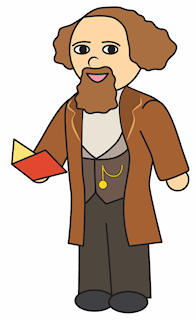
Explore Activity Village
- Famous People
- Famous People A-Z
Become a Member to access 39,215 printables!

IMAGES
COMMENTS
Mark Twain (born November 30, 1835, Florida, Missouri, U.S.—died April 21, 1910, Redding, Connecticut) was an American humorist, journalist, lecturer, and novelist who acquired international fame for his travel narratives, especially The Innocents Abroad (1869), Roughing It (1872), and Life on the Mississippi (1883), and for his adventure stories of boyhood, especially The Adventures of Tom ...
However, his service was cut short in 1861 by the outbreak of the Civil War, which halted most civilian traffic on the river. ... DOWNLOAD BIOGRAPHY'S MARK TWAIN FACT CARD. Mark Twain's Books.
Samuel Langhorne Clemens (November 30, 1835 - April 21, 1910), [1] known by the pen name Mark Twain, was an American writer, humorist, and essayist.He was praised as the "greatest humorist the United States has produced," [2] with William Faulkner calling him "the father of American literature." [3] Twain's novels include The Adventures of Tom Sawyer (1876) and its sequel, Adventures of ...
Twain Writes his Most Famous Books While Living in Hartford. For the next 17 years (1874-1891)‚ Sam‚ Livy, and their three daughters (Clara was born in 1874 and Jean in 1880) lived in the Hartford home. During those years Sam completed some of his most famous books‚ often finding a summer refuge for uninterrupted work at his sister-in-law ...
Updated on September 23, 2018. Mark Twain, born Samuel Langhorne Clemens Nov. 30, 1835 in the small town of Florida, MO, and raised in Hannibal, became one of the greatest American authors of all time. Known for his sharp wit and pithy commentary on society, politics, and the human condition, his many essays and novels, including the American ...
Mark Twain Biography. Mark Twain (November 30, 1835 - April 21, 1910) was an American author, publisher and charismatic humorist. Twain is considered by many to be the 'Father of American Literature' - his best-known novels are ' The Adventures of Tom Sawyer' and 'Adventures of Huckleberry Finn'. Early life of Mark Twain.
The name Mark Twain is a pseudonym of Samuel Langhorne Clemens. Clemens was an American humorist, journalist, lecturer, and novelist who acquired international fame for his travel narratives ...
AUTHORS (1835-1910); FLORIDA, MISSOURI. Mark Twain, author of classic books such as The Adventures of Huckleberry Finn and The Gilded Age (plus a wide variety of short stories and other ...
Mark Twain, orig. Samuel Langhorne Clemens, (born Nov. 30, 1835, Florida, Mo., U.S.—died April 21, 1910, Redding, Conn.), U.S. humorist, writer, and lecturer. He grew up in Hannibal, Mo., on the Mississippi River and was apprenticed in 1848 to a local printer. ... The short story is usually concerned with a single effect conveyed in only one ...
Mark Twain's Biography. by Gregg Camfield, PhD, University of California-Merced. On November 30, 1835, nearly thirty years before he took the pen name Mark Twain, Samuel Langhorne Clemens was born in Florida, Missouri, a hamlet some 130 miles north-northwest of St. Louis, and 30 miles inland from the Mississippi River.
Mark Twain Biography. Born: November 30, 1835. Florida, Missouri. Died: April 21, 1910. Redding, Connecticut. American writer and humorist. Mark Twain, American humorist (comic writer) and novelist, captured a world audience with stories of boyhood adventure and with commentary on man's faults that is humorous even while it probes, often ...
Samuel Langhorne Clemens, age 15, better known by his pen name Mark Twain. Mark Twain was of English, Cornish and Scottish descent. He had six siblings; however only three made it past childhood. The three were Orion (1824-1897), Henry (1838-1858), and Pamela (1827-1904).
Mark Twain aka Samuel Langhorne Clemens (1835-1910) was one of the best known American writers, and is considerd the greatest humorist USA had produced. William Faulkner called him "the father of American literature". He wrote many novels, short stories, travel stories and essays. His best known novels include The Adventures of Tom Sawyer (1876) and its sequel, the Adventures of Huckleberry ...
Mark Twain on the Art of Writing, edited by Martion B. Fried, Salisbury Club, 1961. Selected Shorter Writings of Mark Twain, edited by Walter Blair, Houghton, 1962. Great Short Works of Mark Twain, edited by Justin Kaplan, Harper, 1967. "What Is Man?," and Other Philosophical Writings, edited by Paul Baender, University of California Press, 1973.
Mark Twain suffered from the nasty bout of paranoia and volcanic rages. He also experienced depression and spent most of the time, smoking, reading, and playing cards. Mark Twain died on 21 st April 1910 at the age of 74. Mark Twain's Writing Style. Mark Twain is one of the most important American writers of the 19 th century. The style of ...
Biography: Mark Twain. Samuel Langhorne Clemens (November 30, 1835 - April 21, 1910), better known by his pen name Mark Twain, was an American author and humorist. He wrote The Adventures of Tom Sawyer (1876) and its sequel, Adventures of Huckleberry Finn (1885), the latter often called "The Great American Novel.".
Samuel Langhorne Clemens was born in Florida, Missouri on November 30, 1835. He would later go by the "pen name" Mark Twain as a writer. Young Samuel grew up in the small town of Hannibal, Missouri with his sister and two brothers. The town of Hannibal was located right on the Mississippi River and Samuel loved to watch the river boats pass by ...
Mark Twain (real name Samuel Langhorne Clemens), November 30, 1835 - April 21, 1910, was an American author and humorist. He wrote The Adventures of Tom Sawyer (1876) and its sequel, Adventures of Huckleberry Finn (1885), the latter often called "The Great American Novel". Twain grew up in Hannibal, Missouri, which provided the setting for Huckleberry Finn and Tom Sawyer. After an ...
Died: April 21, 1910. Born November 30, 1835 in Florida, Mark Twain "came in with the comet" and as he predicted "went out with the comet" passing April 21, 1910, the day after Halley's Comet. His real name was Samuel Longhorne Clemens, and he took his pen name from his days as a riverboat pilot on the Mississippi River where the cry ...
Mark Twain Biography. ... Among his California works was "The Celebrated Jumping Frog of Calaveras County," a short story that catapulted him to national prominence and established him as a ...
Biography of Mark Twain. Biography of. Mark Twain. Christened as Samuel Langhorne Clemens, the man who would call himself Mark Twain was born on November 30, 1835 in the small river town of Florida, Missouri, just 200 miles from Indian Territory. The sixth child of John Marshall Clemens and Jane Lampton, Twain lived in Florida, Missouri until ...
A Short Biography of Mark Twain. Mark Twain was born Samuel Clemens in 1835 in Florida, Missouri, USA. He was the sixth of seven children born to John Clemens, a lawyer, and his wife Jane, although three of Samuel's siblings died in childhood. When Samuel was four, the family moved to Hannibal, a town on the Mississippi River.